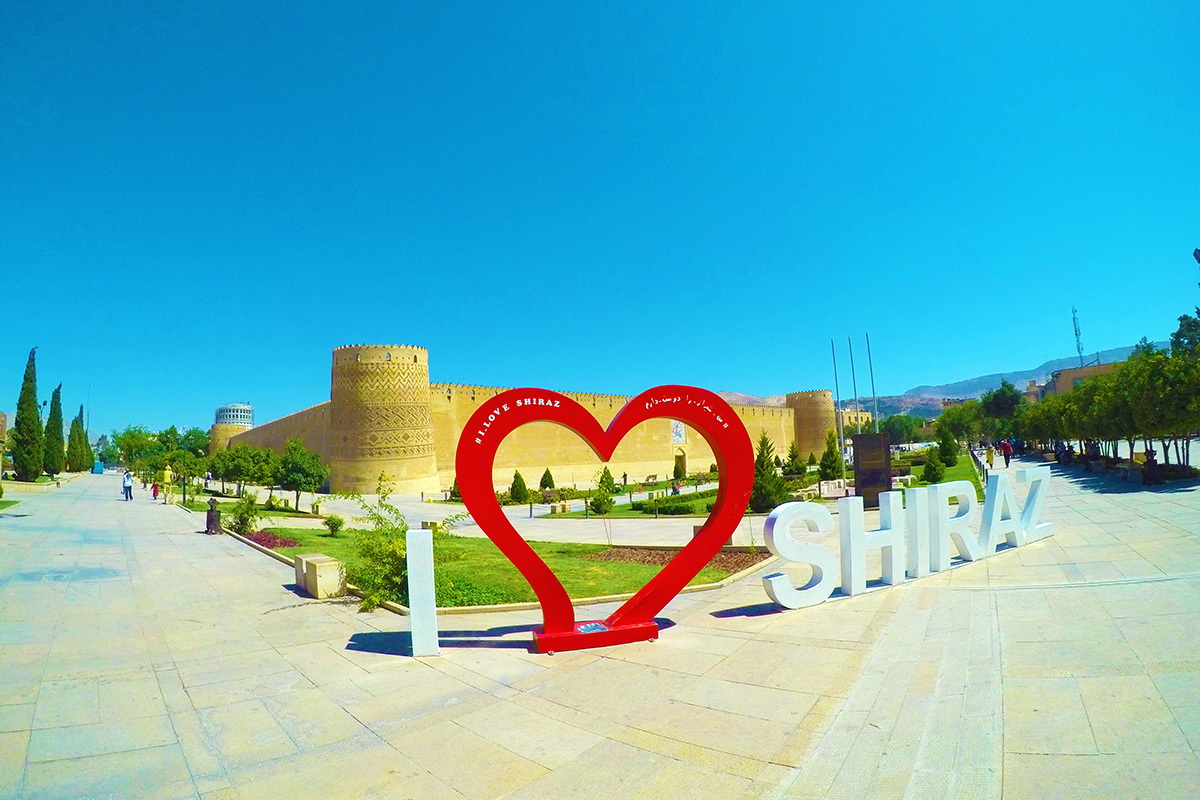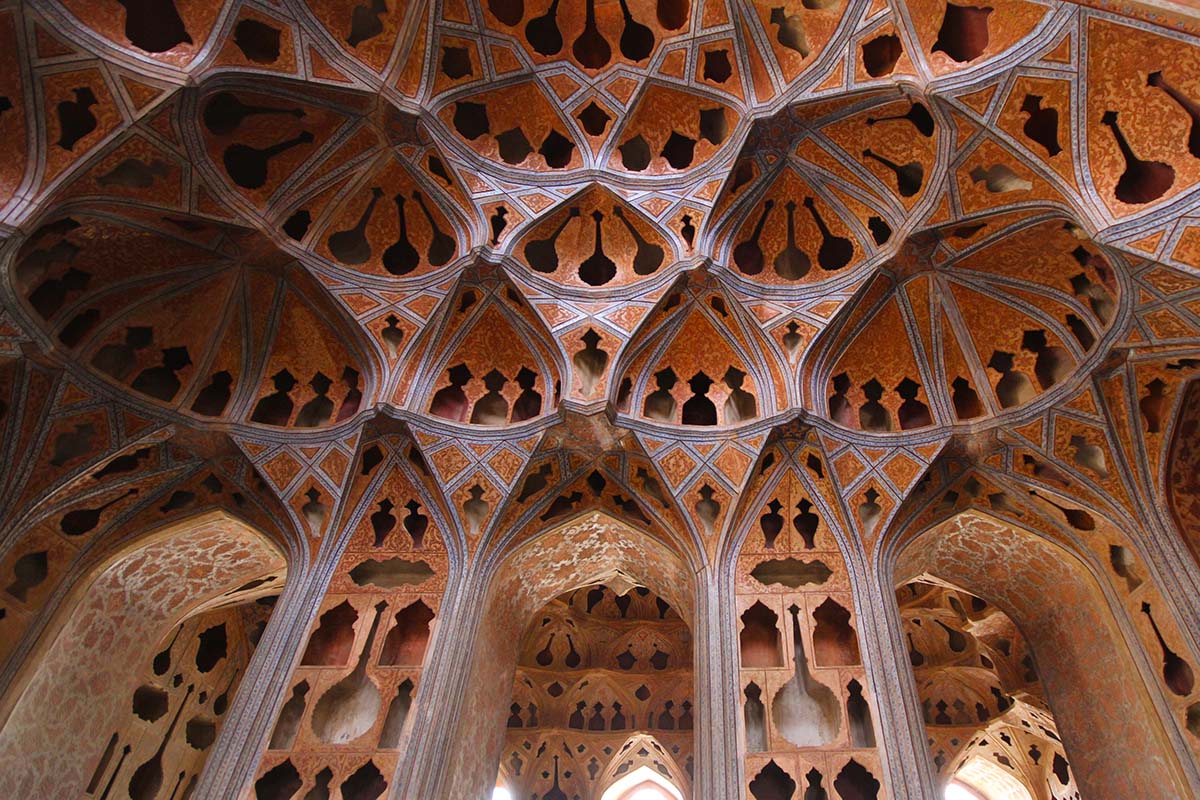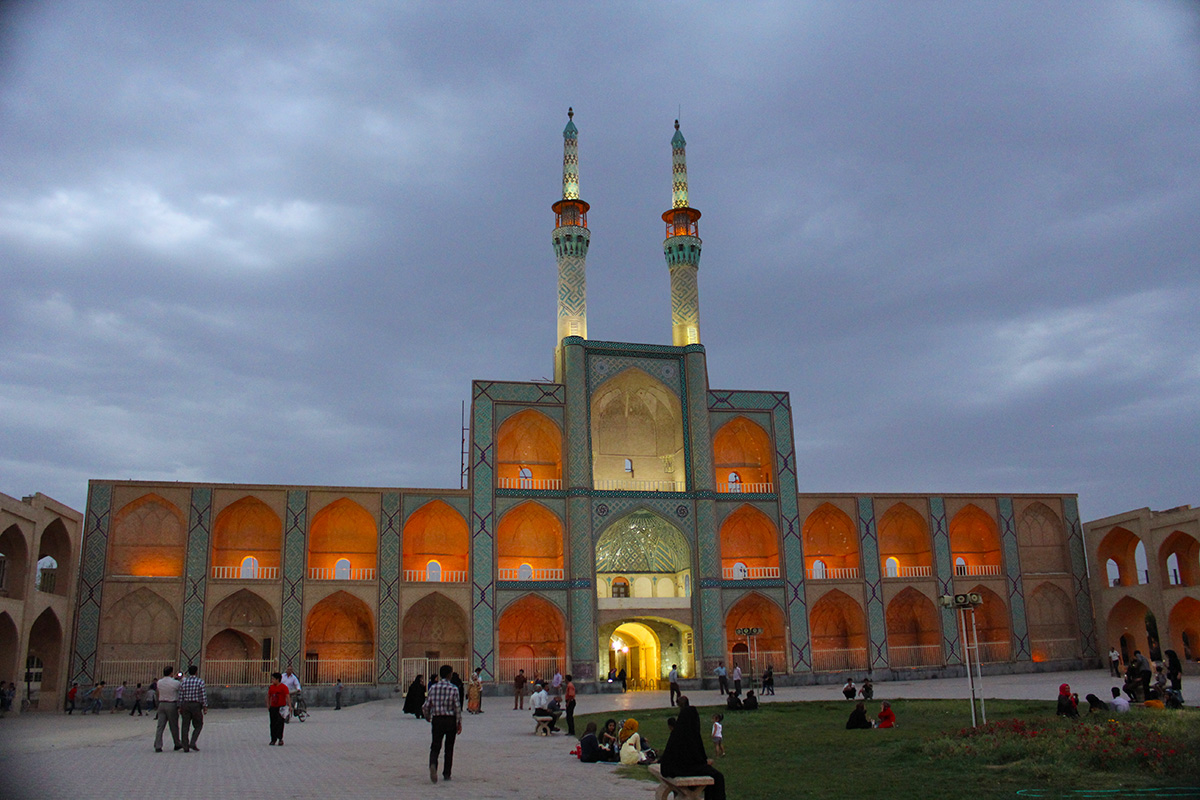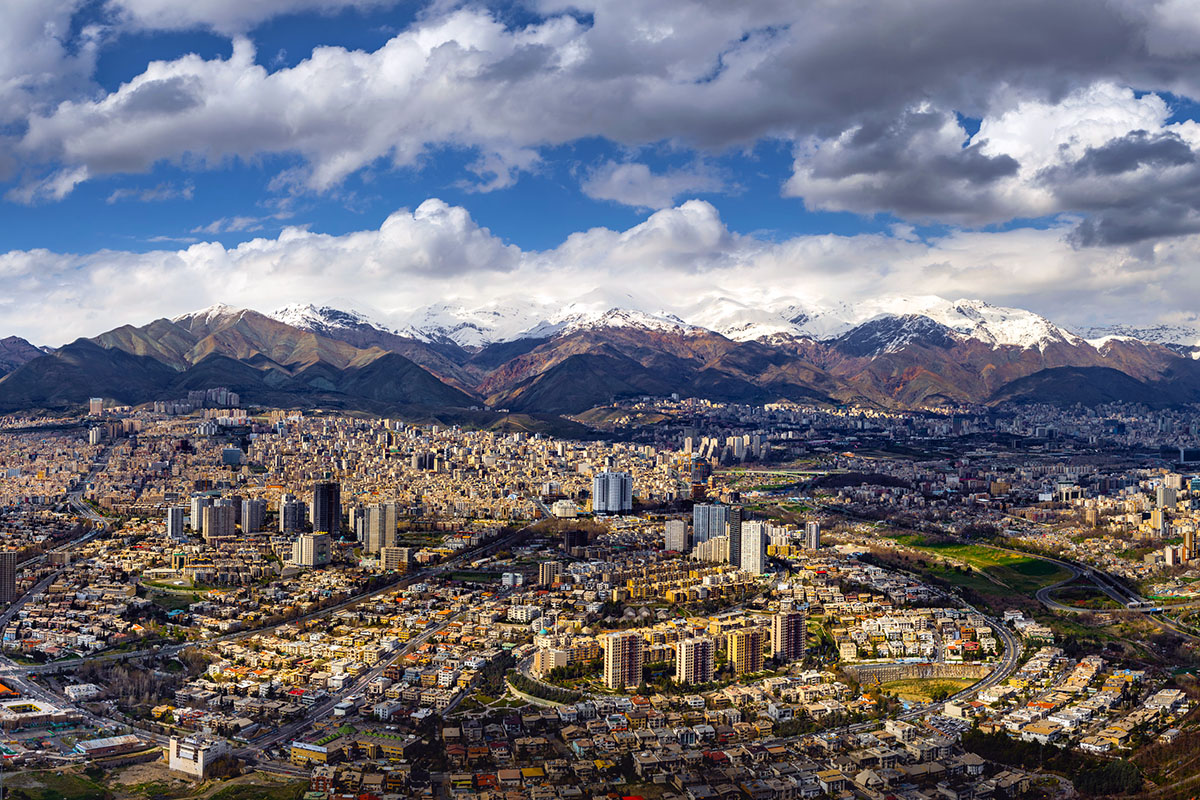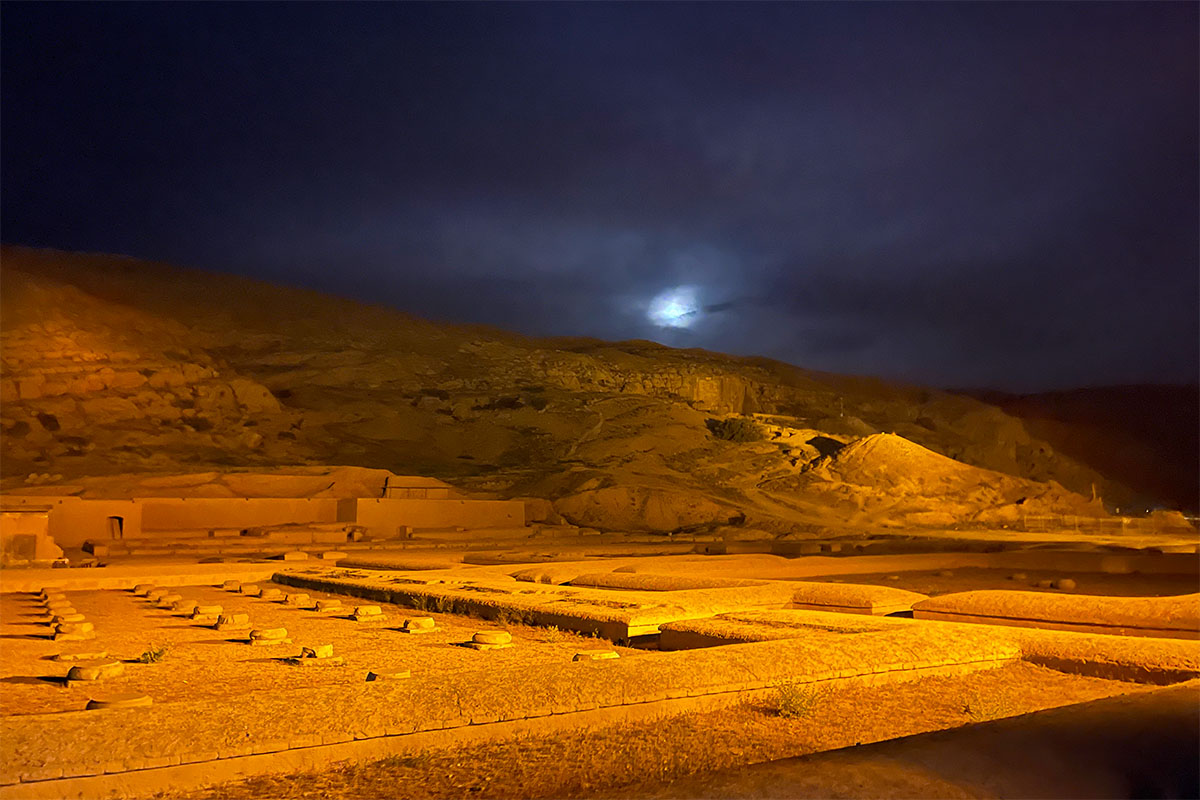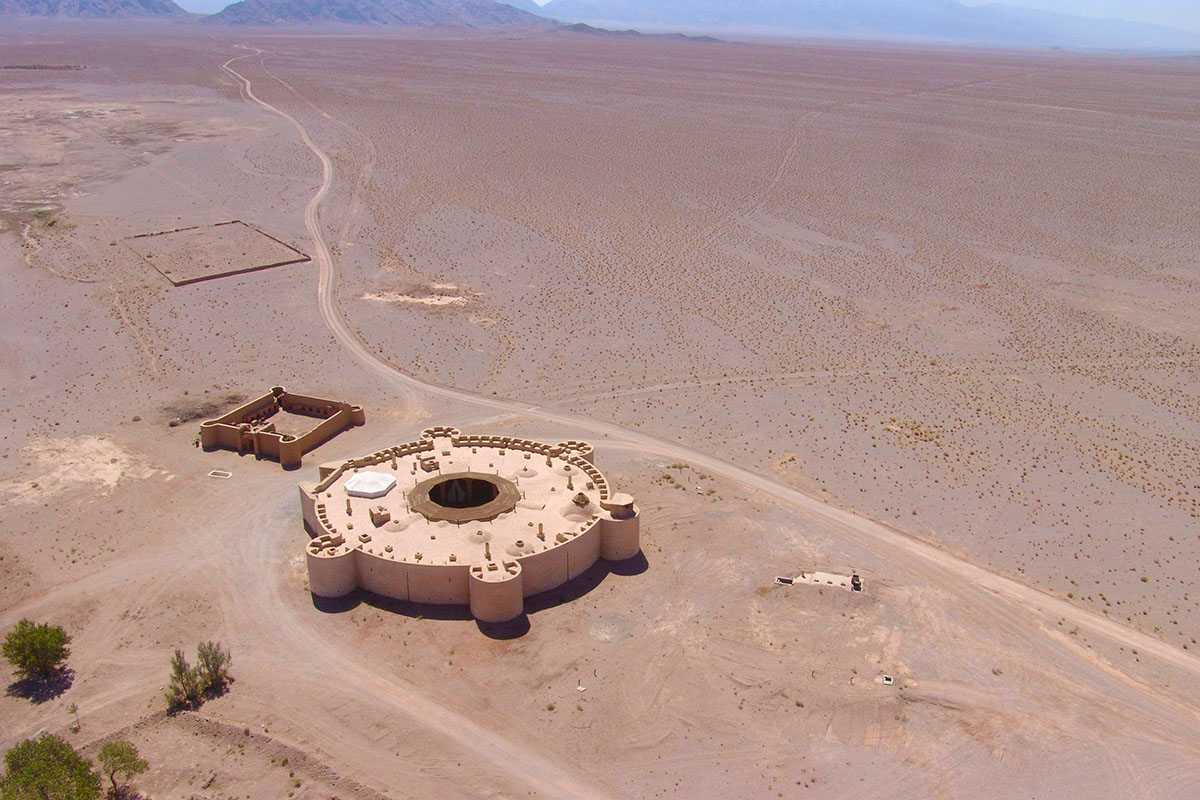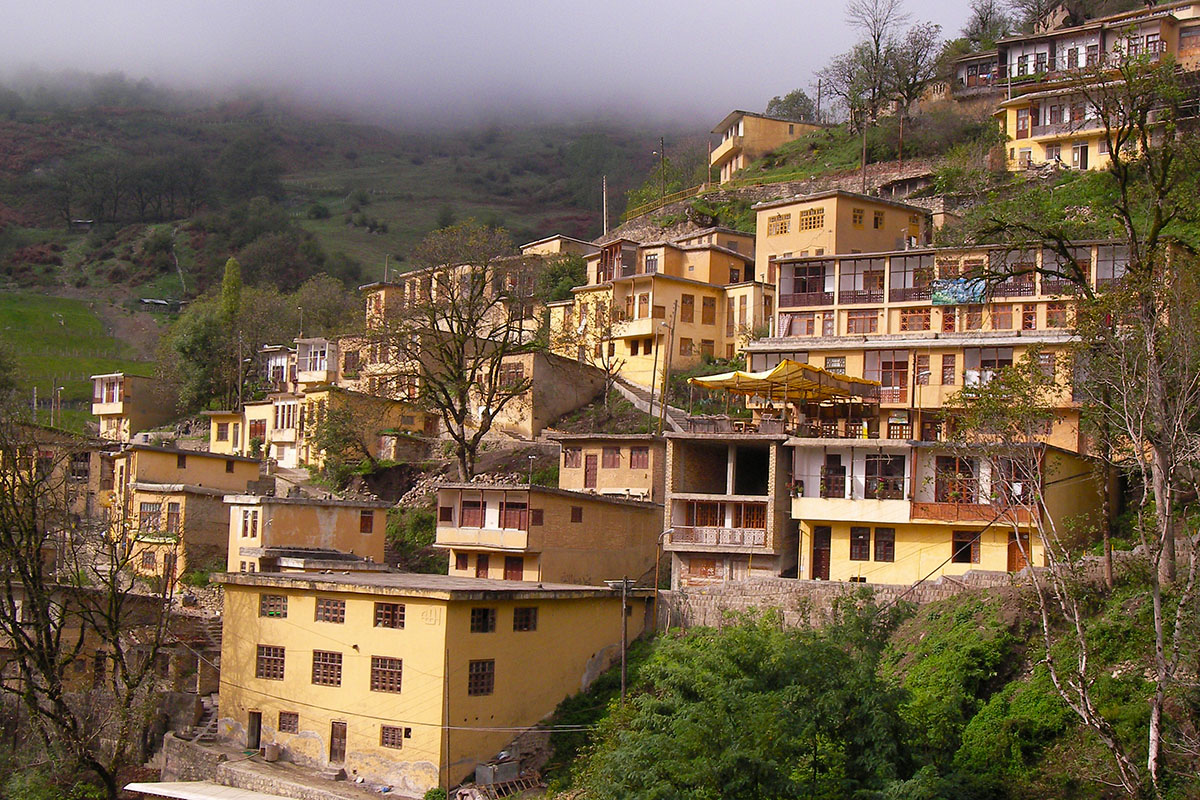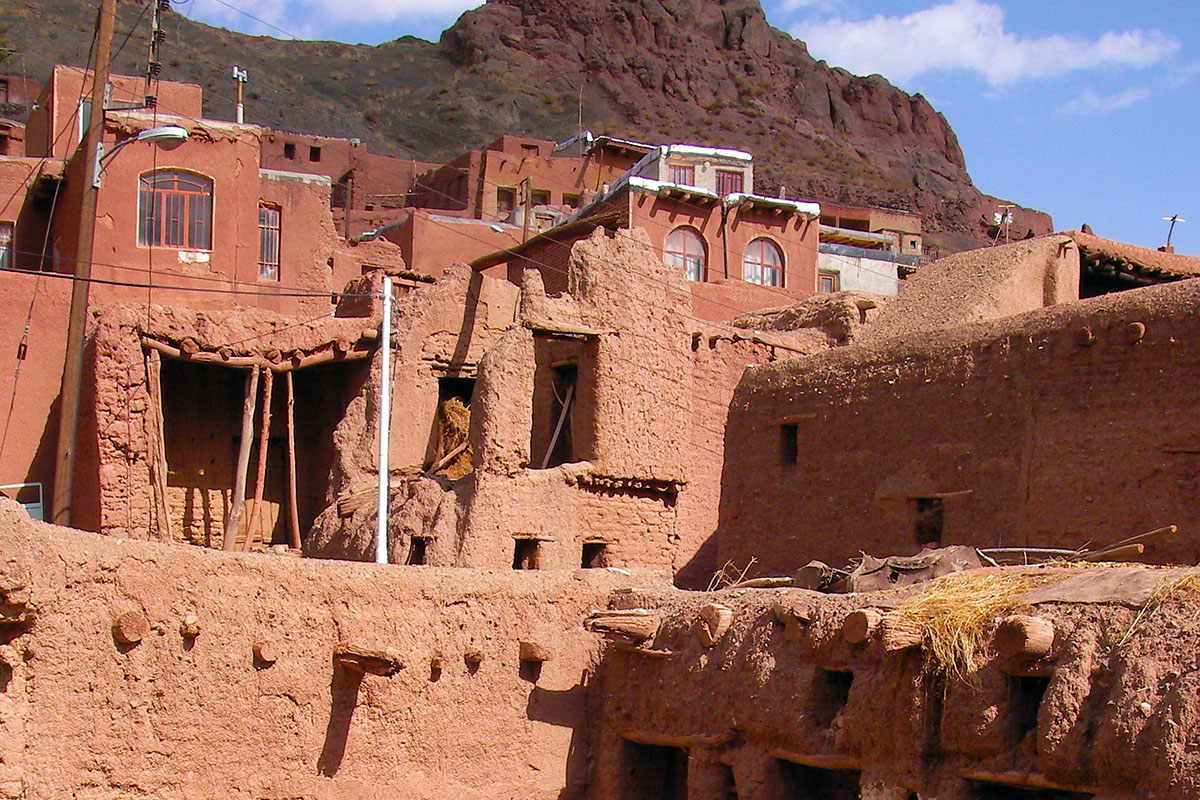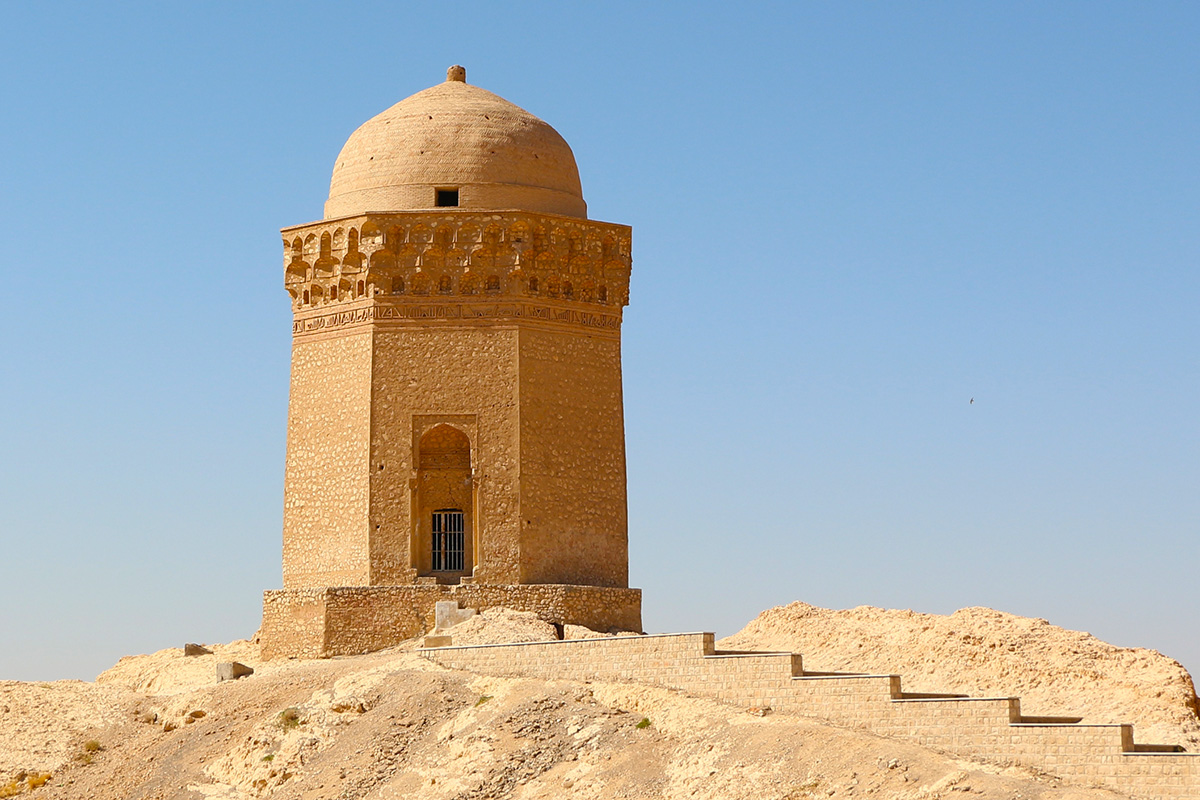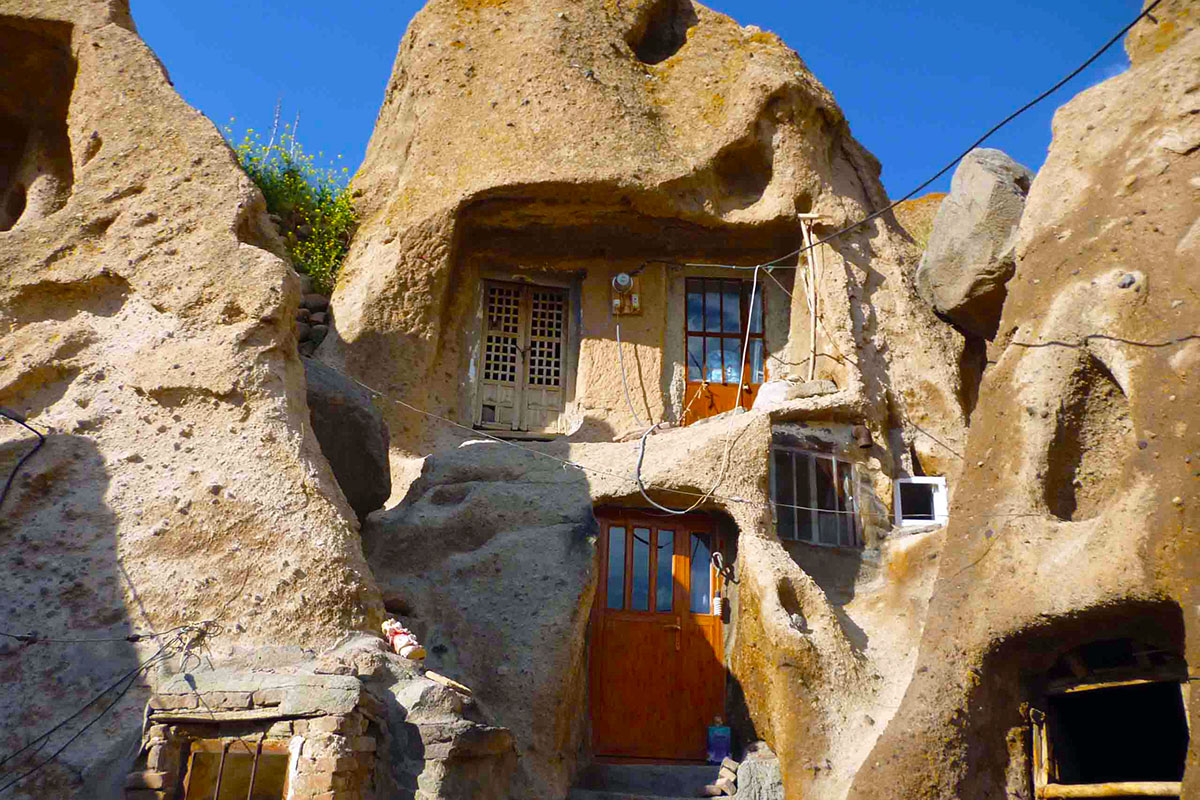Shiraz City
Shiraz city, titled as the City of Flowers and Nightingales, is in Southwestern Iran close to Persian Gulf and is surrounded by Zagros Mountains. Shiraz is home to nearly 2 million people and is the 4th largest city in Iran after Tehran, Mashhad, and Isfahan. Traveling to Shiraz has been a joy and thrill recounted in adventurers travelogues, travel diaries and travel guide books for centuries and posted in Social Media channels and blog posts in Digital World. The city is divided into two distinct parts: the big historical city (360 Hectares) in the middle of the city and the new city which has grown particularly in the Northwest in the last 70 years with the emergence of new residential neighborhoods such as Farhangshahr, Maaliabad, Beheshti and Golestan.
Zand street district which was established outside Bagh-e Shah gate during Pahlavi dynasty is the commercial city center but districts such as Sattarkhan and Maaliabad in modern Shiraz play an important role commercially now. Chamran Blvd and Ghasrodasht Avenue surrounded by gardens are the stomping ground for locals including the so-called "Health Path" car-free walking and cycling areas established for the locals in the last few years. Most of the hotels are located in Zand street and around Sang-e Siah district at the historical part of Shiraz. The modern cafes and restaurants are scattered around Roodaki Avenue in downtown, Khakshanesai and Hafez Avenues in North and Sattar Khan, Ghoddosi, Afifabad and Maaliabad to the West and Northwest of the City.
Table of Contents
- What is it Like in Shiraz
- History of Shiraz
- Geography & Climate of Shiraz
- Monuments & Tourist Attractions in the City of Shiraz
- Shiraz Historical District
- Mosques & Shrines of Shiraz city
- Shah Cheragh Mausoleum (14th century)
- Astaneh Mausoleum (15th century)
- Ali Ebne Hamzeh Mausoleum (10th century)
- Imamzade Ibrahim Shrine
- Jame Atiq Mosuqe (9th century)
- Nasir-ol-molk Mosque (19th century)
- Vakil Mosque (18th century)
- Moshir-al-molk Mosque (19th century)
- Bibi Dokhtaran Shrine (14th century)
- Ahmadi Monastery (20th century)
- The gardens of the city of Shiraz
- Eram Garden (11th century - UNESCO world heritage garden)
- Delgosha Garden (pre-Islamic Persia)
- Afif Abad Garden (16th century)
- Jahan Nama Garden (14th century)
- Chehel Tanan Garden (18th century)
- Jannat Garden (19th century)
- Hafeziyeh Gardens - Hafez Tomb (14th century)
- Saadie Gardens - Saadi Tomb (13th century)
- The Palaces and Mansions of Shiraz
- The Museums of the city of Shiraz
- Other Monuments in Shiraz
- To see in the surroundings of Shiraz
- Persepolis (6th century BC - UNESCO world heritage site)
- Pasargadae (6th century BC - UNESCO world heritage site)
- Naghsh-e- Rostam (13th centry BC, 6th century BC, 7th centry AD - UNESCO world heritage site)
- Firuzabad (2nd century- UNESCO world heritage site)
- Bishapur (3rd century- UNESCO world heritage site)
- Sarvestan Palace (5th century- UNESCO world heritage site)
- Maharloo Salt Lake
- Best place to shop in Shiraz
- Cultural Agenda of the city of Shiraz
- How to reach
- Getting around
- Food and drinks
- Art and Crafts
- Shiraz Monuments & Attractions Tickets Price
- BOOK YOUR SHIRAZ CITY TOUR NOW
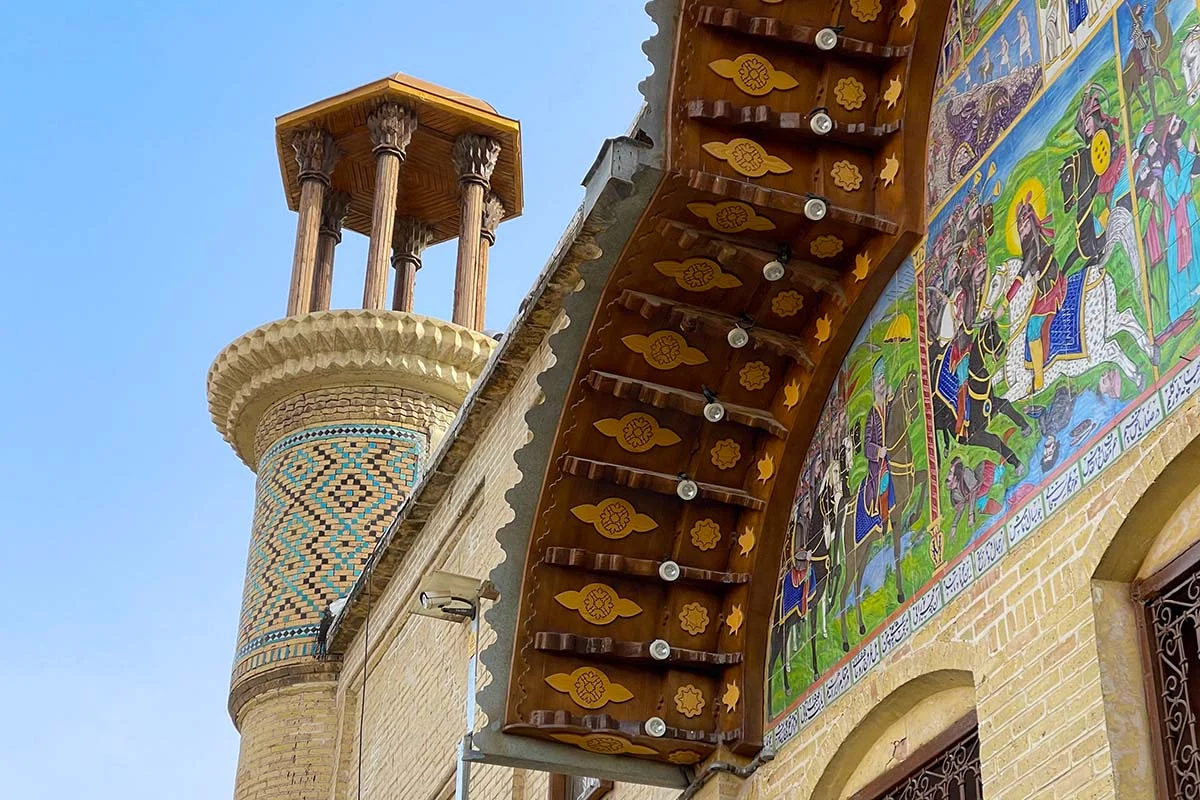
What is it Like in Shiraz
Shiraz is a little bit of everything - an architectural hodgepodge of different Persian styles and elements of architecture in its historical district and a perfect entry point into Persian history and culture; Shiraz is home to many historical gardens, poets tombs, dazzling historical merchants and officials mansions, modern malls and historical bazaars, a variety of local cuisine polished in taste through centuries in history and some of the best grapes traveling around the world in history in a way that some of the best grapes grown in places like Southern France, Australia or South Africa are labeled as Shiraz so it has much to offer to the average tourist and is definitely worth visiting.
History of Shiraz
Mentioned as Tirazis in an Elamite inscription from 20000 BC, what the archaeologists and historians tell us is that Shiraz today was established in 693 AD by Muhammad Ibn Qasem from the Umavid Dynasty after Arabs occupied Persia as Shiraz was located in the middle of prominent cities of the time such as Istakhr, Firuzabad, Darab and Bishapur. But before arrival of Arabs and Islam for at least 25 centuries Shiraz was an area settled by people in castles, the most famous one which is Abu-Nasr fortification and the oldest one recently under excavation Poostchi Hill dating back to beyond 4 millennium BC.
Shiraz was one of the prominent cities in the medieval Islamic world and during Timurid dynasty Shiraz school of art reached one of its peaks and Shiraz paintings and artwork have decorated top museums and private collections around the world now. Shiraz was the Capital of Iran during the Zand dynasty when many of its most beautiful buildings were built and restored. It is also home to splendid gardens, exquisite mosques. During Qajar dynasty many beautiful mansions, houses and gardens were built by Shiraz merchants as Shiraz had kept its importance due to its location close to Persian Gulf and its business with India and China.
The location of Shiraz close to Islands and ports in Persian Gulf such as Hurmoz, Siraf and Bushehr and the activities of Portuguese merchants in Shiraz during Timurid dynasty and from Safavid time the arrival of western merchants and the competition between East Indian Companies of England, France, Denmark and Holland made Shiraz an important commercial city in recent history and the opening of Suez Canal in 1869 during Naser-al-din Shah rein in Persia made Shiraz even more important.
From around 500 BC Fars State known as Persia has been celebrated as heartland of Persian culture and history and was the place of the greatest kings of Persian Empires such As Acheamenids and Sassanids. Fars has hosted some of the important historical events that have marked the identity of Iran. Fars State or Persia had given its name to the entire Kingdom of Persia until it was changed to Iran by the order of Reza Shah Pahlavi to be inclusive of all Iranian ethnic groups.
Shiraz poets are also some of the most popular Persian poets that Iranians usually recite from even after 700 or 800 years after their death. Hafiz and Sa'adi are prominent Persian poets and their tombs are some of the most visited places among Iranian tourist attractions.
Thanks to its historical richness and to this passage of several ruling dynasties, Shiraz is one of the main tourist cities of Iran. In many western historical Narratives and Travelogues the name of the city of Shiraz is mentioned and they have visited Shiraz as it was their main destinations or they had a stop there on their route from West to East for instance from London to Mumbai.
Geography & Climate of Shiraz
Shiraz is a city located on the plain of mountains like Derak mountain from Zagros range. It is undeniable that the geographical situation of the city is ideal. It represents a very privileged crossroads to ensure access to the mountains, the desert and Persian Gulf. It enjoys its tourist attraction thanks to the possibility of making it a rallying and passage point since Persian Gulf is only 296 km away, Sepidan ski resort just 123 km away, Maharloo Salt lake is only 30 km away and by driving for around 250 km you can explore Iranian desert.
The 930 km road from Tehran to Shiraz is a good highway path going through some mountain passes and deserts.
Shiraz is a city where the sun is very present throughout the year. In winter and due to the proximity of the Zagros mountains, this city experiences a great range of temperatures during the whole day. The winter in Shiraz begins around November where at night you can curl the 3 or 4 degrees and the day up to 26.
The rainy days in Shiraz are rare even in winter, and of course the city is not immune to a week of bad weather, which can be very windy and violent with driving rain.The snowy days are very rare but may happen every few years.
Always due to the proximity of the Zagros mountains, in summer the temperatures are very high during the day but drops at night. Generally the summer in Shiraz starts in June and stabilize around 40 degrees during the day and 30 degrees at night in its hottest days.
The sun is present everyday in summer but it is recommended not to expose yourself to it, especially in the time slot from 12h to 17h.
Shiraz in Ordibehsht month (April-May) is very popular for Iranian travelers as the temperature is nice and you can smell fruit blossoms and flowers and the gardens are at their most beautiful shape. The best season where you can enjoy your visit to Shiraz is without a doubt the intermediate one from September to November or from March to June, in this intermediate seasons the climate is very pleasant, the nights stay reasonably cool and the days can be as high as 32 degree.
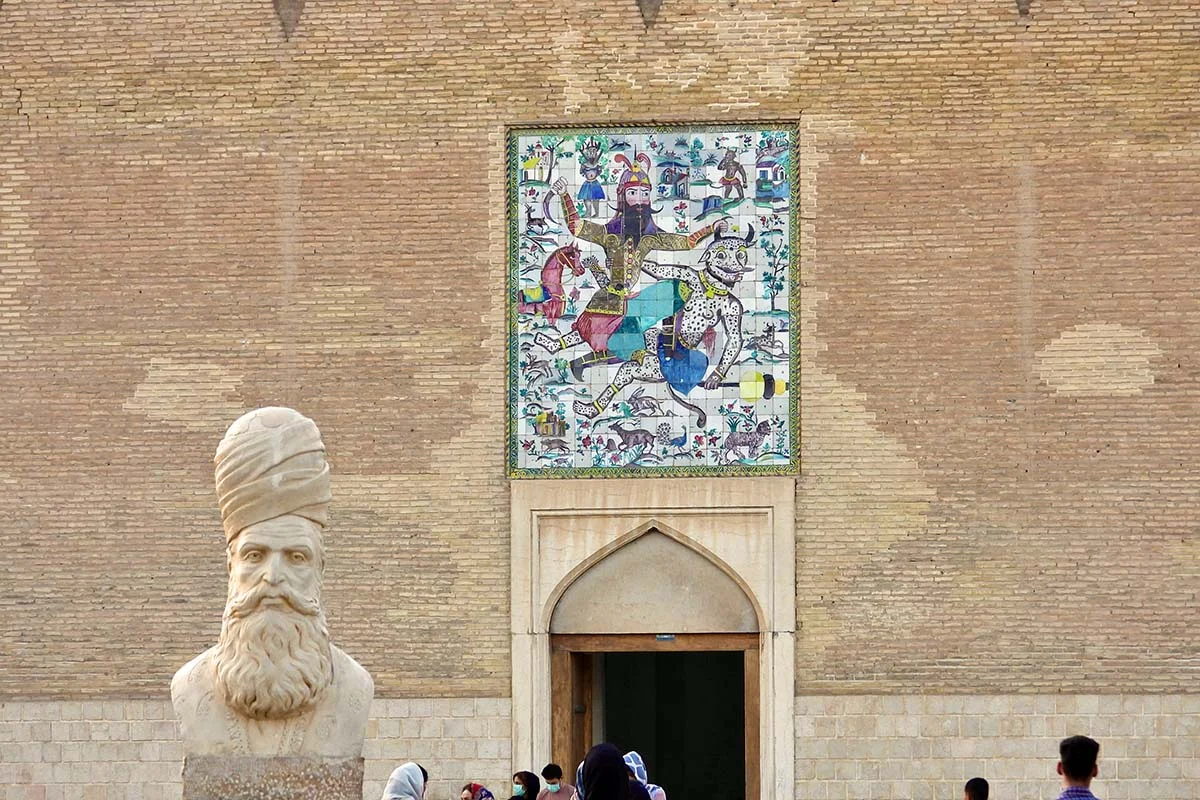
Monuments & Tourist Attractions in the City of Shiraz
Shiraz Historical District
The main attraction of Shiraz is its Baft-e Tarikhi (Historical Quarter of the city) with its main monuments and sites recognized for their heritage value. You find historical palaces, houses, mosques, Medrasas (Koranic schools), Armenian churches, Jewish Synagogues, Dervish buildings (Khanghah and Dargah) and museums.
The old city of Shiraz is subdivided into several sub-districts, the most sophisticated districts are around Darb-e Shazdeh, Sang-e Siah and Qavam district.
In fact the middle and upper classes mostly left the old district when the new districts were built.
Nowadays the old district is mainly popular with more people corresponding to the tourist activity and there is also a return of interest for the old city among the well-to-do classes. The Shirazis are more and more aware of the heritage they have and which they must preserve.
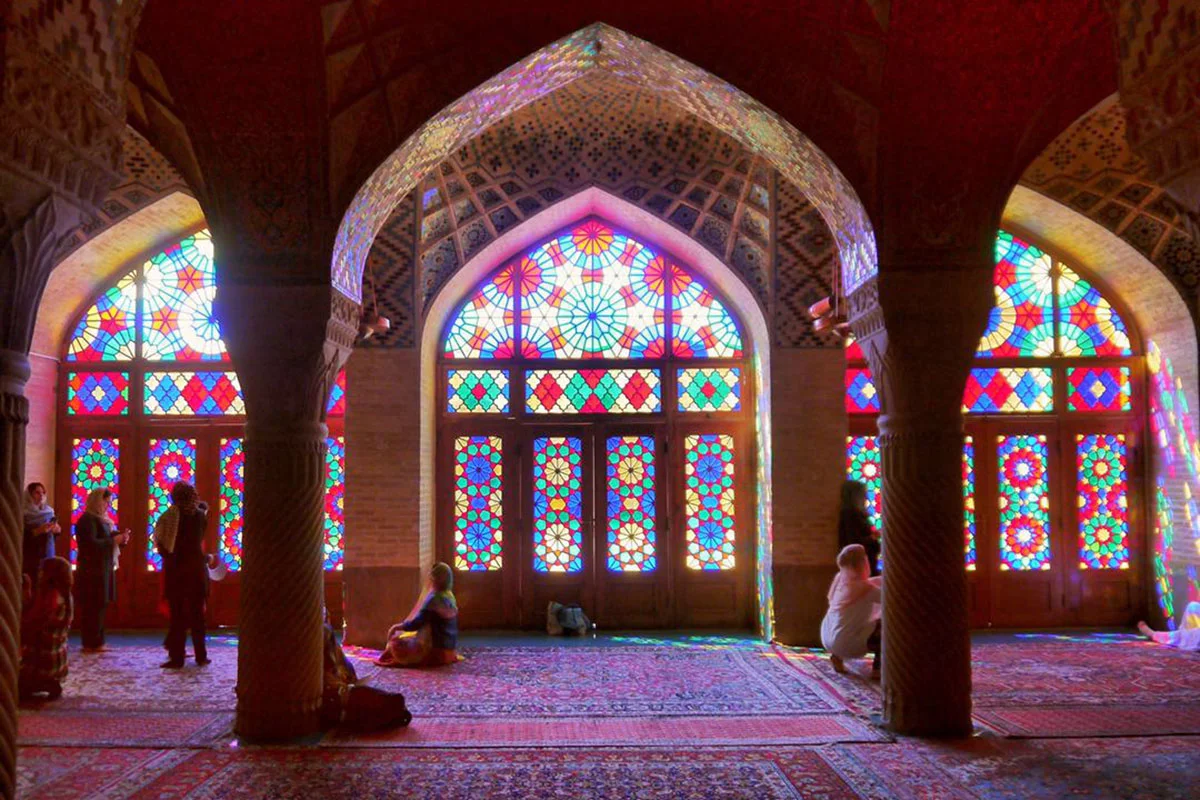
Mosques & Shrines of Shiraz city
Shah Cheragh Mausoleum (14th century)
The burial place of Mir Ahmad son of Musa also known as Shah Cheragh (literally "king! Light!") who is the brother of Imam Reza the 8th Imam in Shiite Islam is located in the center of the historical district of Shiraz in its oldest part. The place of the burial has been discovered in 14th century A.D. and a shrine was built over it afterwards and has been under developments in the last 7 centuries. Each dynasty including Safavids, Zands, Qajars, Pahlavis and Islamic republic have added their elements of Persian art to this shrine. Visiting the shrine gives you serene and peaceful feeling. Its tiled dome, the stained glass windows and multicolored reflections from mirror tiles inside the tomb is spectacular. Around the yard, there are many rooms with brilliant tiled works. Some pillars, windows and doors of shrine are made up of the exquisite wood and inlaid works. Also there are valuable objects on show in the museum and library of the shrine.
Astaneh Mausoleum (15th century)
The Tomb of Seyed Alaeddin Husayn the other brother of Imam Reza who was killed in Shiraz on his way from Iraq to Tus near Mashhad to meet the 8th Imam of Shiites similar to his brother Mir Ahmad and was buried in Shiraz. The original building of Seyyed Alauddin Hossein's tomb belongs to the 15th century A.D. and was developed and restored during Safavid, Zand, Qajar and Pahlavi dynasties. The dome was built during Qajar dynasty and was rebuilt during Pahlavi dynasty while the mirror work inside the shrine was crafted by the sponsorship of Qavam family. The famous tower clock of this shrine was set up during Pahlavi dynasty.
Ali Ebne Hamzeh Mausoleum (10th century)
On the south side of the Quran Gate, near Isfahan Gate and on Hafez Street, there is an eye-catching shrine that is not just the tomb of Ali Ibn-e Hamze the nephew of Imam Reza and Ahmad bin Musa but is burial place of Buyid kings and Zand noblemen including Rahim Khan the son of Karimkhan. The shrine was established in the 10th century A.D. by the order of ʿAḍud al-Dawla Deilami the Buyid king.
The beautiful dome of the mausoleum stands out with exquisite tiling and the tomb is located at the end of the court; Upon entering the shrine, you pass through small rooms and porches and reach the the tomb. Inside the building of the shrine is decorated with beautiful mirror work. The doors and windows of this shrine are decorated with the art of Marquetry and inlaid work on wood.
Imamzade Ibrahim Shrine
The mausoleum of Imamzadeh Ibrahim who is supposed to be one of the children of Imam Musa Kazem is located in Shiraz near the Dar al-Salam cemetery and the current building mainly belongs to Qajar and Pahlavi dynasty.
One of the beautiful parts of this building is the wall inside the courtyard in which beautiful paintings of the Day of Resurrection and Ashura scenes are depicted in "Seven Color Tiles" tile work. On the north side of the courtyard, Imamzadeh tomb is located, and on the south side of the courtyard, a hall with two columns and several rooms can be seen. Inside the shrine hall, one will come across beautiful mirror works that will dazzle the eyes of every viewer. The holy shrine is located in the southern hall and it is made of wood and silver. The floor of the shrine and the walls up to a height of 1.5 meters are covered with marble, and all the ceilings and arches inside the shrine are mirrored, and on the top of the holy shrine in the ceiling of the southern throne, a beautiful mirror has been created with the technique of Muqarnas (stalactites). It is built in the Zandieh style and single-colored tiles are used.
Jame Atiq Mosuqe (9th century)
Atiq Mosque of Shiraz is the oldest mosque of Shiraz and is also known as Adina or Friday Mosque. The construction of this mosque dates back to 894 A.D. and during the reign of Amr Laith Safari.
As Atiq Jame Mosque of Shiraz contained political, social, cultural and political activities and was a busy place so it had 6 entrance doors, each of which is used in different cases. One door on the north side, one door on the south side, two doors on the west side and two doors on the east side are the 6 doors of Atiq Jame Mosque in Shiraz. It is located in the eastern part of the Shah Cheragh Shrine, and one of its entrances opens to the Shah Cheragh Shrine. The northern side and Ivan of the mosque is one of the most important entrances which was rebuilt in the Safavid period.
If you are standing in the middle of the courtyard of the Old Grand Mosque of Shiraz, the Khodakhaneh building, which is located exactly in the middle of the courtyard, is within your range of vision. It was established on 1351 during Ilkhanid dynasty and was allocated to keeping books including beautiful Shiraz school paintings.
Nasir-ol-molk Mosque (19th century)
َ A must-see in Iran, Nasir al-Mulk Mosque, also known as the Pink Mosque, was built by the order of one of the nobles of Shiraz from Qawam family named Mirza Hasan Ali Khan, nicknamed Nasir al-Mulk. Nasir al-Molk entrusted the construction of this mosque to two prominent architects named Mirza Reza Kashigar and Haj Mohammad Hassan Memar, and they built the best mosque they could during 12 years in 1888. One of the most popular features of this structure is the stained glass windows of the nave, which were made by Master Mohammad Jafar and Master Mohammad Rahim, two prominent Shirazi carpenters. The dazzling Mogharnas (Honeycomb structure) makes the mosque even more beautiful.
Nasir al-Mulk mosque is located in Goud Araban neighborhood, south of Lotfoali Khan Zand street, near the tomb of Shah Cherag shrine and it is about 2890 square meters. The mosque has one entrance to Nasir al-Molk alley and two other entrances, one to the southern alley of the mosque and the other to Imamzade next to it. The Imamzade Zanjiri tomb and its nice dome were built by the order of the same Nasir al-Mulk during Qajar dynasty.
Vakil Mosque (18th century)
Vakil Mosque of Shiraz is one of the monuments built in 1774 A.D. by the order of Karim Khan Zand during Zandiye period when Shiraz was the capital of Iran. This mosque with an area of approximately 11,000 square meters, 120 meters long, 80 meters wide is located in the neighborhood of Darb Shahzad, current Taleghani Street and between Hammam Vakil and Bazaar Vakil and includes a luxurious entrance door with amazing tilework, the courtyard, the north and south porches, the south and east porches, the east and west porticoes and the small side yard. The Nave of the Vakil Mosque in Shiraz has 48 integrated stone columns with a spiral design, 5 meters high and 80 cm in diameter, with matching arches and beautiful tiling.
Moshir-al-molk Mosque (19th century)
The beautiful mosque of Moshir al-Mulk in Shiraz was built in 1896 A.D by the order of Abulhasan Khan Moshir Al-molk a prominent merchant and nobleman of Shiraz. This mosque is an outstanding work of Iranian architects in the Qajar period in Shiraz with amazing tile work in different and rare styles.
The oldest tower clock of Shiraz is in Moshir al-Mulk mosque. This clock is placed on the west arch of the mosque. The clock numbers were originally English; But due to Mirza Abul Hasan Moshir al-Mulk's attention to Persian language, they were converted into Persian. Architects have used a special method in making clocks. They increased the height of the clock so that the bell would ring louder in the mosque.
Bibi Dokhtaran Shrine (14th century)
The tomb of Bibi Khadija or Umm Abdallah, the granddaughter of Imam Sajjad known as Bibi Dokhtaran is located in Sang-e Siah neighborhood, and Beg Khatun, the mother of Shah Shuja, ordered the construction of this tomb during Al Muzaffar period in the 14th century.
This shrine has a very beautiful dome and its building consists of two floors. In the courtyard of this Imamzadeh, you will see a square pond in front of the tomb, which is decorated with two very beautiful gardens on both sides. Umm Abdallah's tomb is located under the ground of this shrine, and the tomb of Abdullah Mubarak is located outside the tomb on its northern side. There are doors on all four sides of this building, and porches are built around these doors. These porches have very beautiful arches.
Ahmadi Monastery (20th century)
Ahmadi Monastery is one of the Pahlavi buildings of Shiraz city, which was built in Sar-e bagh district. and has been the meeting place of the Dhahabiyyah (Ahmadi) dervishes. In the construction of this building, various types of Iranian architectural art have been used, such as tile work, inlaid work, gold work, brick work, and mirror work. This monastery includes a museum, a library, a clinic, as well as the tombs of the elders of the Ahmadi Dervishes such as Mirza Ahmad Abdulhai Mortazavi Tabrizi and Haj Mirza Mohammad Ali Hob Haider Ardabili. Among the valuable works of the museum of this monastery is a Quran written by the great teacher Ali Asghar Zarmehr over 20 years.
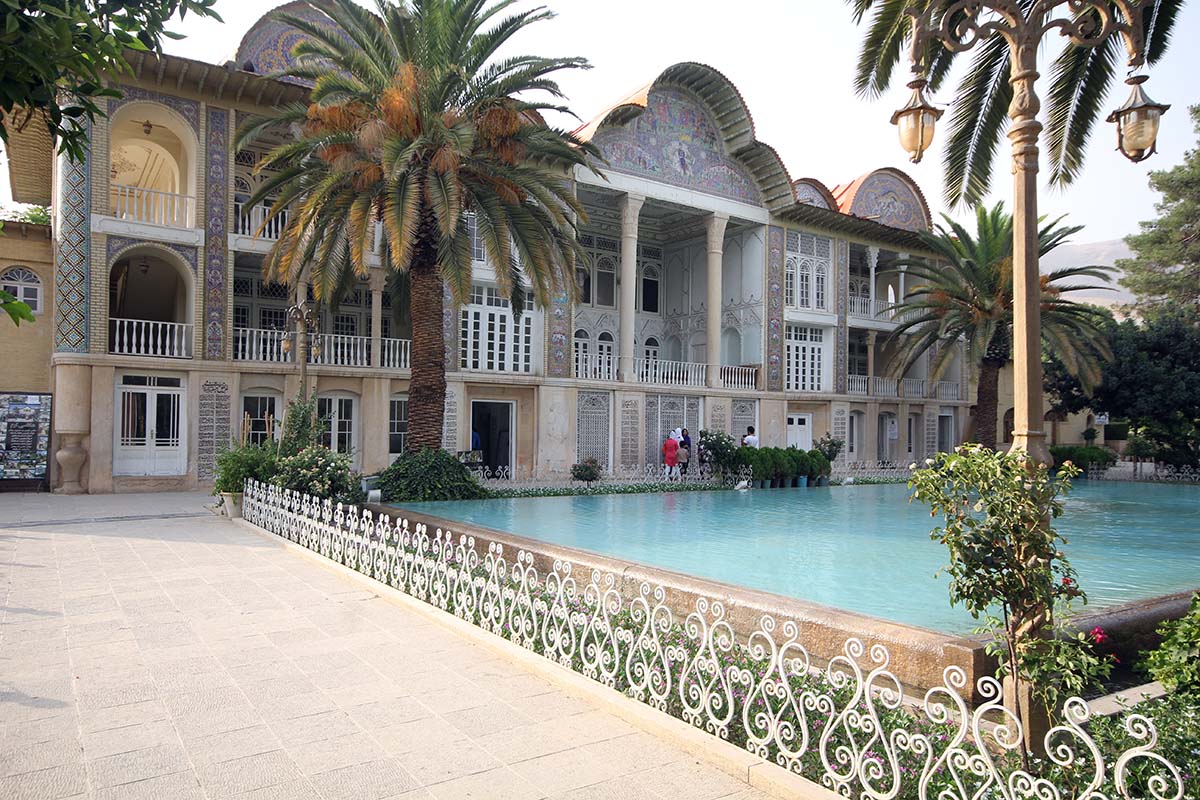
The gardens of the city of Shiraz
Eram Garden (11th century - UNESCO world heritage garden)
The Eram Garden or garden of paradise is one of the UNESCO world heritage gardens in Shiraz that is very popular for tourists. The establishment of the Eram garden dates back to the Seljuk dynasty in 11th century. The architecture, carving, tiling and other architectural remnants of Eram garden have made a masterpiece for the Qajar period.
Eram Garden was in place during the Safavid, Seljuk and Al-Inju eras and was restored by Karim Khan Zand. At the end of the Zand dynasty and with the arrival of Qajars and Fath Ali Shah, the main mansion of Eram Garden in Shiraz was built by the first Ilkhan Qashqai and his son Mohammad Qoli Khan. Later during the reign of Naser al-Din Shah, a person named Haj Nasir al-Molk Shirazi bought this garden and based on the initial design of the main building, he built a mansion in it that has survived until now.
Delgosha Garden (pre-Islamic Persia)
The history of Delgosha garden in Shiraz goes back to the Achaemenid and Sassanid eras. This 7.5 hectare historical garden has enjoyed some development during Tamerlane reign. Timur Gorkani, the first king of Timurid empire built another garden with the same name in Samarkand after visiting the Delgosa garden in Shiraz. The current mansion of the garden was built during Qajar dynasty and was renovated several times since then. The garden itself has been redesigned several times during Pahlavi and Islamic Republic dynasties.
In Ordibehesht of Shiraz (April-May) the Naranj (Sour Orange) trees that are most prevalent in this garden blossom and their beauties and smell attract many visitors to this Persian garden.
Afif Abad Garden (16th century)
The history of this garden goes back to the Safavid dynasty, when it was known as Golshan Garden. After the Safavid dynasty, this castle was destroyed and this garden lost its prosperity for many years. In 1863 AD Mirza Ali Mohammad Qawam-al-Mulk built the current mansion and garden. The total area of the complex is about 127 thousand square meters. At the end of the Qajar era, this garden fell into the hands of Afifeh Khanum, the niece of its founder and since she played a great role in its restoration and expansion, the garden is titled after her name.
The first floor of Afif Abad mansion is the military museum and you can see a complete collection of all kinds of hot and cold weapons that have been used throughout the history of Iran, from the pistols of Naseruddin Shah and Muzaffaruddin Shah Qajar to the personal rifle of Mohammad Reza Shah Pahlavi.
The name of the second floor of the museum is Ebrat, and it may seem a bit strange at first glance. You can see items left from the Pahlavi era including the piano that was played in the celebration of the 2500th anniversary of the Shahshahi.
All floors of the mansion have very beautiful stucco. The roofs have detailed designs and between the windows you can see stone carvings in the shape of flowers and plants.
Jahan Nama Garden (14th century)
Titled by a historian during Timurid dynasty as "the Ornament of the World" Jahannama Garden in Shiraz dates back to Muzaffarid dynasty in the 14th century and with an area of 2.8 hectares has 3500 square meters of green space. Most of the greenery of Jahannama is made up of stout and old trees of cypress and orange, green boxwood, pink rose, violet, petunia and chrysanthemum flowers. This octagonal mansion has 4 Shahneshins (alcoves) with two-story rooms located between these alcoves. This building has a brick facade and have wooden windows. Inside the mansion there is also a pool of solid marble. The mansion in the middle of this garden belongs to the Zand period. The streets surrounding the mentioned mansion along with beautiful tree plantations were done in 1771 AD by order of Karim Khan Zand.
Chehel Tanan Garden (18th century)
Chehel Tan or Forty People Garden dates back to the Zand dynasty. In this garden, there are forty small graves in two rows next to each other. These 40 graves belong to 40 dervishes who probably lived and worshiped in this garden and when each of them died, the others buried him. Their graves are placed next to each other on the eastern side of the yard next to the wall.
These gravestones have no inscription and between their two rows there is a small garden where flowers are planted. In 1841 AD, by the order of Motamed al-Doleh Farhad Mirza Qajar, the ruler of Fars at the time, forty tombstones were cut to the same size and placed on the graves parallel to each other without any writing. In the gardens of Chehal Tanan, a renown poet of Shiraz named Sheikh Abu Ishaq Etameh (died 1427 AD) is also buried. He poems on Persian food and Shirazi food are an important source for food historians on cooking during Timurid dynasty.
Jannat Garden (19th century)
Jannet Garden that functions as a big and nice public park popular for locals in Shiraz is located in the Koshan district, on the west side of Shiraz city. In this garden that was establsihed during Qajar dynasty, there used to be a fine mansion of Mushir al-Mulk Sufi buildings which does not exist anymore. Jannat Garden was established by Haj Mirza Abul Hasan Khan Moshir al-Mulk In 1844 AD. This garden was later the place of negotiations between Qashqai nomads chief, Qawam, the local governer of Fars and the English consulate in Shiraz during Qajar dynasty.
In Jannat garden there are manycypress and pine trees. Ttall and beautiful cypresses that are placed at certain distances. The garden is grassed over and water fountains have been placed in this garden, all of which together have created a pleasant atmosphere.
Hafeziyeh Gardens - Hafez Tomb (14th century)
Hafez Gardens containing the tomb of Hafez, one of the most popular Persian poets (1325–1390 AD), is located in the north of Shiraz city and was built in 1935 AD with the efforts of Ali Asghar Hekmat and found an important place in contemporary Iranian architecture and in the minds of the visitors in a way that the name of Hafez is mixed with the image of his grave in the mind of every Iranian.
Before the construction of the new structure over Hafez grave that is decorated with a nice marble stone built by the order of Karim khan Zand and the planning and building the garden by Andre Godard during Reza Shah Pahlavi reign, Hafez tomb was located in a public historical cemetery. The total area of Hafezie is about twenty thousand square meters and is still expanding. According to Godar's plan, the four-pillared hall of Karimkhani was extended from two sides, and by adding sixteen more columns with a height of five meters, a larger hall with a length of 56 meters and a width of seven meters was built.
Hafez gardens and tomb is one of the most visited monuments in Iran and visiting Hafez tomb and reciting his poems is quite popular among Iranians and Shirazis.
In this historical complex, there are various trees such as cypress, pine, elm, orange, weeping willow, etc. and based on old photos from the Qajar period, most of these trees are more than 200 years old.
Saadie Gardens - Saadi Tomb (13th century)
Saadie in Shiraz city is the burial place of one of the greatest Iranian poets, Saadi (1210-1291 AD) who has a worldwide reputation and every year thousands of tourists from inside and outside Iran come to Shiraz city to visit his tomb and enjoy its beautiful garden and its cypress trees. The building was built during Pahlavi dynasty in 1952 over the remnants of another structure that was built and expanded during Safavid, Zand and Qajar dynasties and the interior design has an open plan decorated with beautiful tile work. Visiting this garden will be attractive for two groups of enthusiasts. The first group of people who are interested in authentic Iranian architectural art. The second group of people who love Persian poetry and literature. This tomb has a pleasant and unique appearance. There is a large pond in the middle of the the tomb, which makes the environment clean and beautiful.
After years of traveling, Saadi lived rest of his life in Shiraz and died in 1291 in the same place where his mausoleum now stands. It is the octagonal shaped building which its wall inscribed with Saadi’s work. Saadi's porphyry gravestone was built in 1860 by the order of Ali Akbar Khan Qawam.
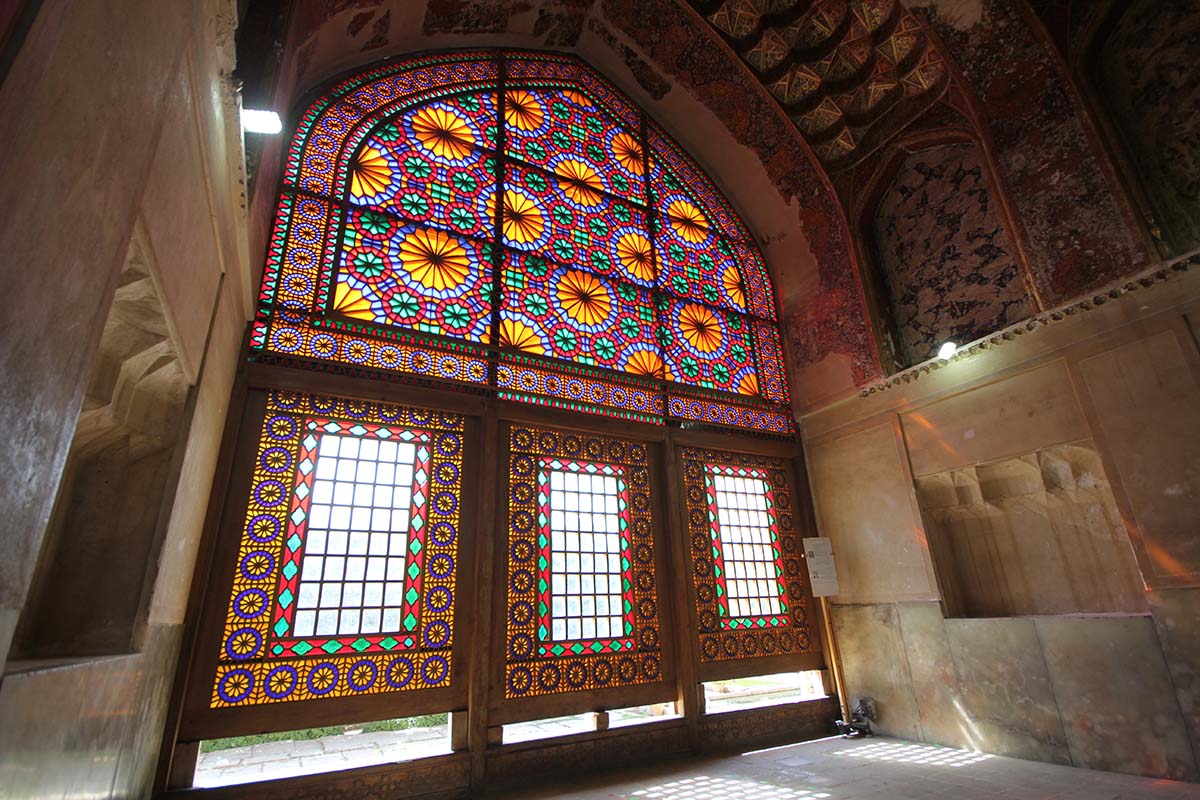
The Palaces and Mansions of Shiraz
Karim Khan Citadel (18th century)
Arg-e karim khan citadel in Shiraz, which has a rectangular plan and has a big pool and orange trees, was built in 1766 by Karimkhan Zand. originally it was used as the interior and living place of the royal family as well as the command headquarters of the Zandiye dynasty.
With its four circular towers dominates the city center and also the whole old town could be seen. It is a combination of two military and residential architecture so this well-preserved monument used to the mansion of Karim Khan Zand in 1766-7 and during the Qajar period it was used as the governor's seat. In Pahlavi era it was a prison for a while. On the exterior walls, simple dazzling brickwork is visible.
On the north side of this building, a backyard with several small rooms was built. On the southern front of the citadel, a Zandieh-style Hammam was built, which is still standing. This bathroom has four solid stone pillars that are inside the thermal house and are decorated beautifully.
Qawam Mansion (19th century)
The construction of the mansion and garden of Qawam al-Mulk in Shiraz, which is known as Narenjestan of Qawam, finished in 1886 during the reign of Naser al-Din Shah Qajar by the order of Muhammad Ali Khan Qawam al-Mulk.
The Qavam family was considered one of the influential families of the Qajar era, which ruled Fars for many years. In addition to Narenjestan Qavam mansion and garden, many historical and scenic places and mansions in Shiraz, such as Delgosha Garden, Afif Abad Garden, Kalantar Garden, and Bigler Begi Garden, were built by this family.
The garden of sour oranges fruit or Naranj in Persian is called Naranjestan as we say in Persian. The paintings on the low ceilings of the house are inspired by the Victorian era. Every room contains special kinds of architecture including paintings on the ceilings, wall and fire places. The most beautiful of all rooms is mirror porch which is also the focal point of the houses.
In the second Pahlavi period, Ibrahim Khan, the last survivor of the Qawam-ul-Mulk family, made changes in the buildings before his death and then donated this historical and beautiful garden to Shiraz University in 1967 for artistic and cultural activities. In 1970, it was donated to the Asian Institute of the famous American Iranologist Arthur Abraham Pope, and it was in the possession of this institution until 1980.
Zinat-Al-Molk House (19th century)
This beautiful mansion is located at a short distance on the left side of the Narenjestan garden, which is known by this name because it was the residence of Zinat al-Maluk Qawam. This house is actually considered to be interior of the Narenjestan garden; A place where the people of the house and the eunuchs used to go. Zeintul-Molk mansion leads to Narenjestan mansion with an underground passage. This route has now become a museum of wax figures of notable people of Shiraz.
The construction of this beautiful historical mansion finished in 1886. The construction of the building was initially carried out by Mohammad Khan Qawam (Qawamul-Mulk II), but finally Mohammad Reza Khan (Qawam-ul-Mulk III) finished it. The entrance of the house of Zaint al-Muluk has decorations; It is paved, through the portico you pass, there is a passage that enters the courtyard of the building with a northeast angle. There are two beautiful gardens and a large and small pond in the yard. The decorations of the house of Zaint al-Muluk are also spectacular and appreciable. In the upper part of the building, you can see tiles that are arranged in a crescent shape and in seven different colors. Images and patterns can also be seen in the building. For example, there are pictures of the sun, two angels, two lions with swords in their hands, and verses from the Quran on the walls.
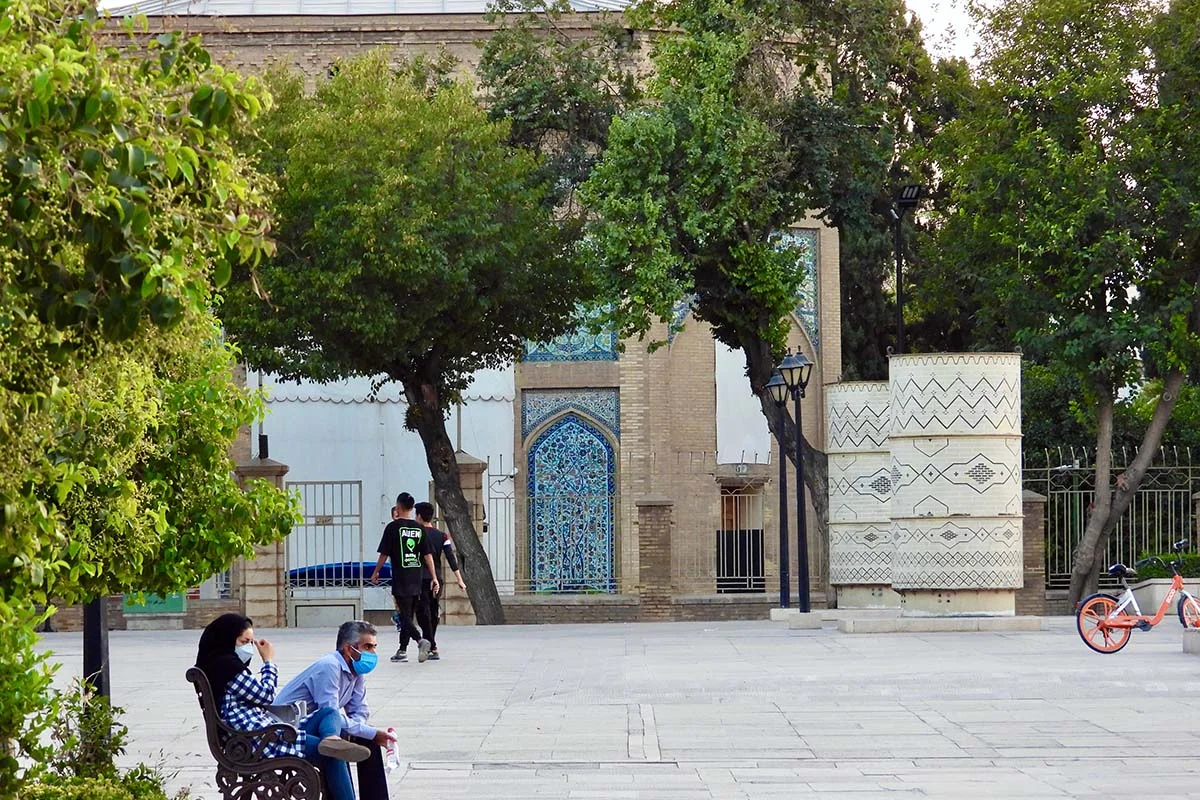
The Museums of the city of Shiraz
Pars Museum (18th century)
The pavilion in the middle of Nazar garden was built by the order of Karimkhan Zand to be his burial place but Agha Mohammad Khan the first king of Qajar dynasty moved his corpse from Shiraz to Tehran when he defeated the last Zand king. In 1937 this pavilion was converted to a nice museum. This garden has been standing in Shiraz since the Zandiya era and was built by the order of Karim Khan Zand. During the reign of Zandiyeh Karim Khan's citadel and hall of reception or Diwan Khana and the octagonal mansion of Kolah Farangi were built in the area of this garden. During Qajar period, Nazar garden in Shiraz was considered as one of the best gardens in this city. Hossein Ali Mirza Farmanfarma, the son of Fath Ali Shah Qajar and the ruler of Fars at the time, built buildings in the northwest corner of the garden and named them "mirror" and "sun". At the moment only the Kolah Farangi mansion remains in the garden, which is also known as the Pars Museum.
Haft Tanan Museum (18th century)
The stone museum is located at the entrance of Shiraz city. When you pass under the Qur'an gate, you can see a beautiful museum garden on Haft Tanan Boulevard, which is called Haft Tanan Museum because of the presence of 7 tombstones in this place. The garden dates back to several centuries before Zandiyeh, and the mansion has remained from the era of Karim Khan Zandeh. Not long time ago this garden was actually a monastery of dervishes and monks, which has now been restored and has become famous among the people as a stone and tile museum.
Haft Tanan Mansion has two parts. On the second floor and the northern part you can see its beautiful hall. On the two stone pillars of this hall, patterns have been drawn with paint and oil. The carvings of these two pillars, which have a special meaning, are stunning.
Forough Al-Molk House and Museum (20th century)
Forough-ul-Malek House in Sang-e Siah district of old part of Shiraz close to Bibi Dokhtaran shrine has been turned into a museum of visual arts with the efforts of the Meshkinfam family and is one of the most spectacular historical houses in Shiraz. A part of this mansion has been also converted to a nice hotel called Forough Boutique Hotel.
In 1932 during Reza Shah Pahlavi reign, General Forough Al-Molk (later police chief of Shiraz) decided to build a three-story mansion in one of the best neighborhoods of the time. 17 years later he donated this mansion to be used as a school for children.
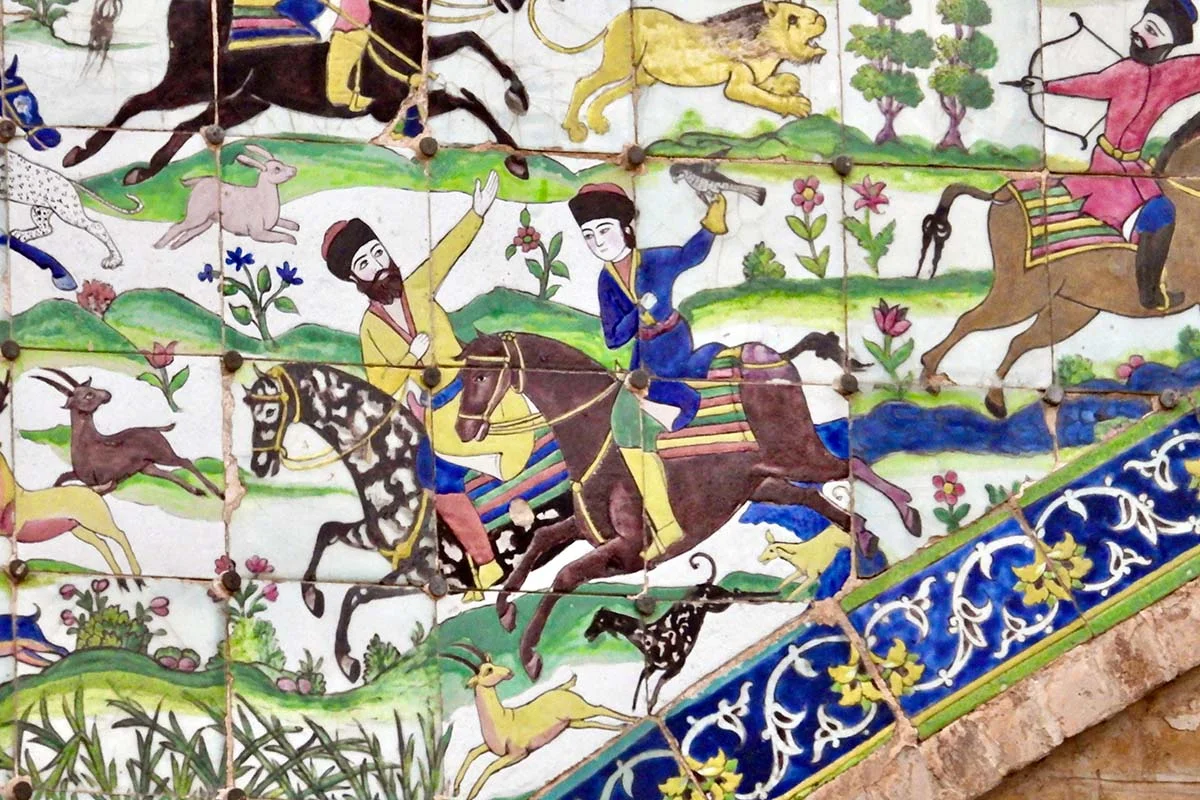
Other Monuments in Shiraz
Quran Gate (10th century)
This original gate was first established around 950 AD by the order of Azod al-Dula Dilami the Buyid king north of Shiraz. At that time, stone and mortar were used to build the gate, and a Koran was also placed on top of it to bless the travelers. Karim Khan Zand rebuilt this structure and created a room for the Quran. Then two volumes of Quran were placed in this room. These Qurans are written in the beautiful script of the Timurid period of Sultan Ibrahim, which became known as Seventeen Kilograms or Seventeen Man Qurans. The Quran Gate has been rebuilt several times due to natural disasters. During the Qajar period, Muhammad Zaki Khan Nouri rebuilt this structure after an earthquake that occurred in this area. Also, around this gate, two chambers were built for security, and a cellar was used to store cool water to quench the thirst of travelers.
In 1937 the mayor of Shiraz destroyed this structure so that cars could pass more easily. But in 1950 Hossein Igar, who was one of the Iranian-English merchants of the time, established a new building for this gate with larger dimensions.
Khaju Kermani Tomb (13th century)
Kamal al-Din Abul-Ata, known as Khajui Kermani, was born in Kerman province during the reign of the Mongol rulers in Iran in 1290 Aِ.D. He is one of the talented Iranian poets whose lyrical poems mostly have mystical themes written in Iraqi style.
The tomb of Khajui Kermani is located in the north of the city of Shiraz, at the foot of Mount Sabui. This tomb was built in 1937 A.D. and is in front of the Quran Gate. Rokn Abad spring water also passes by this tomb. There is a nice view of Shiraz after you climb the steps to visit his tomb.
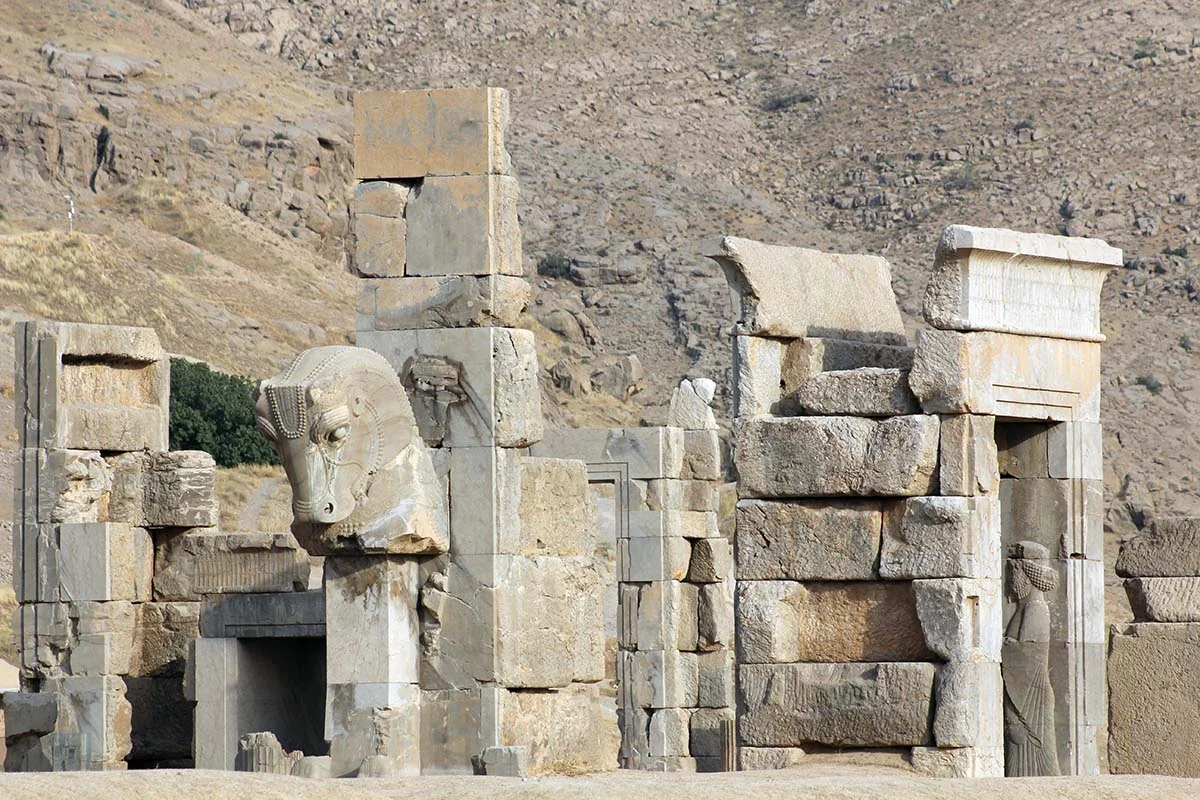
To see in the surroundings of Shiraz
Persepolis (6th century BC - UNESCO world heritage site)
Located 55 KM away from Shiraz, Persepolis or Takht-e Jamshid is a UNESCO world heritage site. The construction of Persepolis started around 530 BC and after the death of Darius the great, his successors continued the construction of this building and completed their own palaces on the platform east of Rahmat mountain. A large number of workers, painters, architects and masters were involved in the construction of this complex, who in addition to receiving salaries, also benefited from the benefits of labor insurance.
The size of the palaces of Persepolis is 125,000 square meters, and it is placed on a platform with a height of 8 to 18 square meters. Among the important and official palaces of Persepolis are the Palace of the Gate of Nations, the Royal Treasury Apadana Palace, Hadish Palace and Tachar Palace. Each of which is very beautiful in its own way.
Pasargadae (6th century BC - UNESCO world heritage site)
Pasargadae was established by Cyrus the great as the first capital of Acheamenians and is 130 km north of Shiraz. This plain is at an altitude of 1850 meters above sea level and has an area of 190 square kilometers. This region has a mountainous climate that is mild in summers and relatively cold in winters.
The tomb of Cyrus the Great is the most valuable remaining building of this ancient city. However, other monuments exist in this area. Remains of monuments such as the Gate Palace, the Reception Palace, the Exclusive Palace, the water canals of Royal Garden or Pardis, the winged man and the defensive structures of the city can be seen near the tomb of Cyrus the Great.
Naghsh-e- Rostam (13th centry BC, 6th century BC, 7th centry AD - UNESCO world heritage site)
Naghsh-e Rostam also known as Necropolis is an important site as it contains works from three historical periods.
First, only a relief from the Elamian period. Part of this bas-relief was later destroyed during the Sassanid era and replaced by the figure of Bahram II and his companions. So this place has been the focus of different dynasties since 1200 BC to 650 AD.
There are also the Catacombs of four of the great Achaemenid kings into the mountain: Darius the great, Xerexes, Artexerexes the first and Darius the second.
Another important building in the complex is Kaabe Zartusht or "Kaaba of Zoroaster" from ancient Persia but its exact function and time of construction is not clear yet.
Several bass-reliefs also exist from Sasanian dynasty. These prominent carvings express historical and mythological narratives of that era. Scenes such as the coronation of kings or the battles of the Sasanian era are carved. The relief of Ahuramazda and Ardeshir Babakan is one of the most beautiful and nice reliefs of the Sasanian era located in this area. Ahura Mazda has a human form in this relief and is riding a horse in front of Ardeshir. To emphasize the greatness of these two horses, they are depicted smaller than their natural state. This illustration tells about the gift of Farah Ezadi to Ardeshir Babakan.
Firuzabad (2nd century- UNESCO world heritage site)
Located 95 km away from the historical city of Shiraz in the southwest of Fars, Firuzabad was the first royal capital of Sassanians established by Ardashir Babakan (180–242 AD). This city with its ancient and historical background, along with its pristine and amazing nature and dozens of historical and natural attractions can be an attractive destination for various tourists. During Sassanian period the city was called Gur and was planned with circular architecture.
Firuzabad land has been home to Qashqai nomads for centuries.
The palace of Ardashir Babakan , Ghaleh Dokhtar or "The Maiden's Castle, Ardashir I bass-relief and the remnants of Gur city are among the places to visit in Firuzabad.
Bishapur (3rd century- UNESCO world heritage site)
The city of Bishapur was built in 266 AD by the order of Shapur I and the name of this city is taken from his name. Bishapur is located between Persepolis and Tisophon near Bishapur river. This river is considered the center of economic and agricultural supply of those regions. Egyptian architecture named Apsai has been responsible for the planning and construction of this city. Roman captives were also used to build the city. Bishapur is recorded as the first ancient Iranian city with a history of urban development and it is registered by the Sassanian king on the pillars still standing.
It is 140 km drvng from Shiraz on the way to Bushehr and Persian Gulf. Anahita temple, Bishapur city, the founder pillars, Shapur cave and Statue and the Sasanid Bass-reliefs in Tang-e Chogan are must-see when you are in Shiraz.
Sarvestan Palace (5th century- UNESCO world heritage site)
Sarvestan Palace is located in Fars province, 90 kilometers away from Shiraz and was built during the Sassanid reign of Bahram Gur in the 5th century AD. The latest archeological investigations in the Sarvestan palace show that this Sassanid complex had an area of about 30 hectares on its best days.
Sarvestan Palace was built using materials such as stone, brick and plaster. The main facade of the building is located on the south side, which includes a central porch and two porches around. A square-shaped porch with a length and width of 13 meters and a height of 18 meters is built in the central part of the palace, which leads to the main hall and the courtyard. The northern part of the building leads to the outside area of the palace with a few steps, and the southern part leads to another side porch. The large eastern porch is connected to the central hall and other parts of the building. Also, on both sides of this building, there are two narrow rooms with a cradle arch, which are not opposite each other. For placing and strengthening the domes, squinches have been used, respectively; In addition, the columns are responsible for protecting and restraining the roof.
Maharloo Salt Lake
The Salt lake of Maharlo is located 30 km away in the southeastern part of Shiraz. This lake is located in the neighborhood of an old village with the same name. The caravanserai in the village was one of the stops for the caravanserais moving from Shiraz to Persian Gulf Islands including Hormuz Island. In April a variety of migratory birds including Falmingos are around this lake and is a great time to visit it.
Shiraz Salt lake is also called pink lake. Evaporation of water in this lake is very high in summertime. This intense evaporation has increased the salinity of this lake that has caused the proliferation of a special type of red seaweed. The excessive growth and proliferation of this algae in the pink lake of Maharlo has caused the water to turn red.
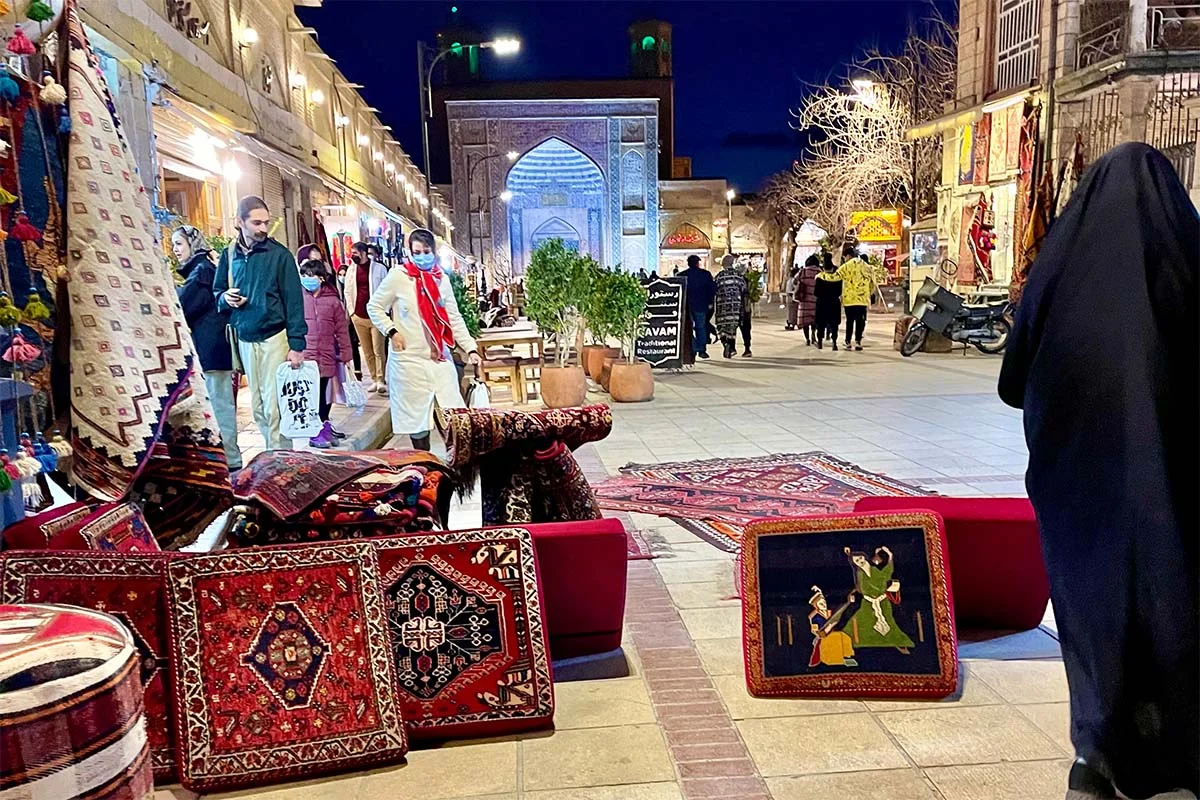
Best place to shop in Shiraz
Vakil bazaar
Vakil Bazaar of Shiraz city has been a part of a large complex that was created by the order of Karim Khan Zand when he chose Shiraz as the capital of Persia. It was built in 1773 but was completed in about 20 years with the cooperation of a group of architects and famous craftsmen of that time.
This Bazaar is still a popular and busy place for locals and travelers for shopping. Fabrics, carpets and handicrafts are the most poular items in this Bazaar.
Saraye Moshir
This bazaar is located in the southeast of Vakil bazaar and is connected to Urdu bazaar from the south. Due to its proximity to Vakil Bazaar as well as architectural similarities, the two markets may be confused. It is a popular place for locals and travelers and was establsihed during Qajar dynasty by the order of Abolhasan Khan Moshirolmolk in 1872.
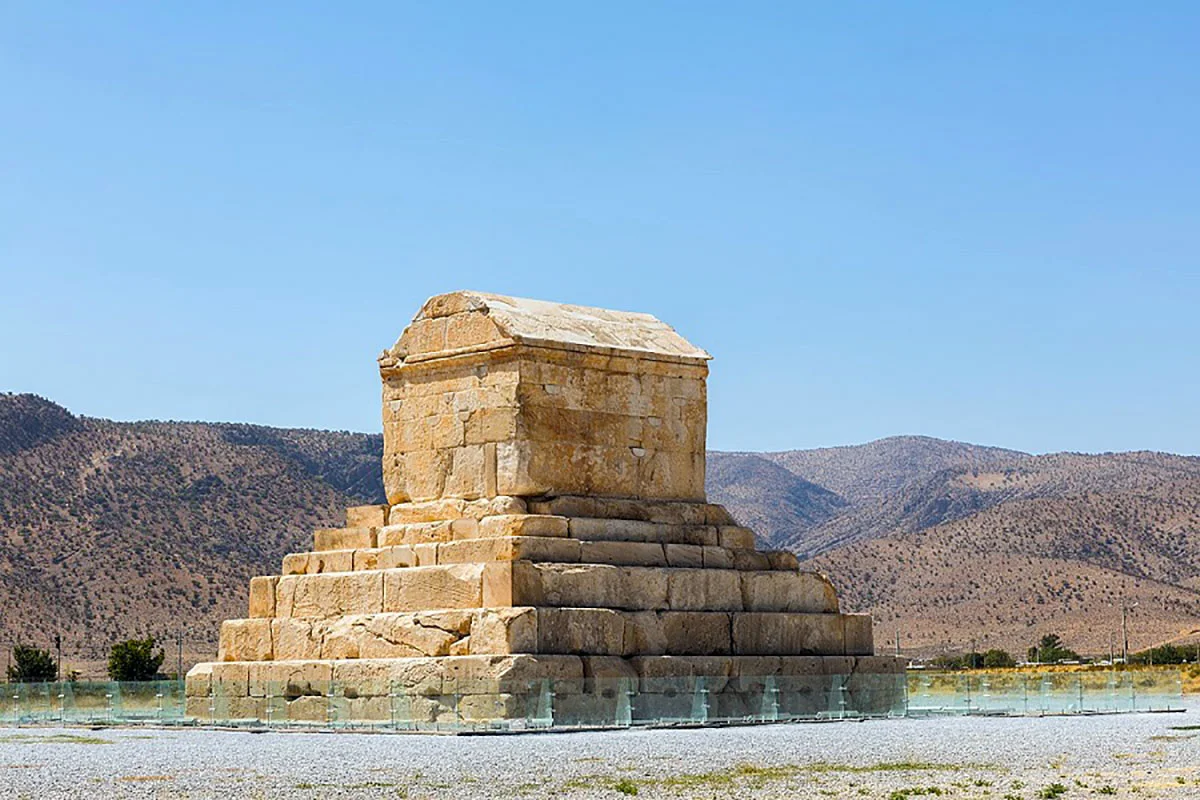
Cultural Agenda of the city of Shiraz
Shiraz Day (May 5)
Shiraz is the city of love and poetry, a city full of passion especially in the nice weather of Ordibehesht. When you step into this city, you will be mesmerized by its beauty. Indeed, Shiraz city is deserved to have a day in its title in Persian calendar. Ordibehesht 15 or May 5 is named Shiraz Day.
Cyrus the Great Day (Oct 29)
On the seventh day of Aban (Oct 29), 539 BC, Cyrus the Great entered Babylon. According to the customs of the time, the people of this city had imagined that the arrival and rule of this ruler in their city will be accompanied by killing and looting. But contrary to their imagination, Cyrus and his soldiers did not do that and even this righteous king issued a decree of freedom and equality in this city. This king has been mentioned in history as a generous and good-natured person. He is considered the founder of human rights, the founder of the first multinational and great empire in the world, the liberator of slaves and prisoners, the respecter of various religions and cults.
Hafez day (Oct 12)
Mehr 20 (Oct 12) is marked in Persian calendar in the name of the great man of Persian poetry and literature, Khwaje Shamsuddin Mohammad Hafez Shirazi, and every year on this day, various programs are held in his tomb and in the city of Shiraz for this the great lyricist of Persian language who has unparalleled popularity in Iranian culture and literature.
Saadi Day (April 21)
The first day of Ordibehesht, the day of the beginning of writing the Golestan book, has been titled as Saadi Day by the Saadi Studies Center of Iran. Saadi was an avid traveler and a great writer and poet.
How to reach
By Air
Shiraz is well connected with domestic and international flights, to all the major cities within and outside of the country. Most of the major international airlines such as Turkish and Qatar airways have their daily flights operating from Dastgheeib Shiraz International Airport.
By Train
Shiraz is served by daily train services to the major cities in the country such as Tehran, Mashhad and Isfahan.
By Road
Bus services to several domestic destinations operate from Shiraz bus stations. The three major bus stands are Bus Terminal at Safar Street, Kave Bus Terminus and Amirkabirs Bus Station. The paved road system, equipped with speed limit record, makes it possible for a fantastic drive and you can catch glimpses of the beautiful landscape. Usually, the maximum speed for driving in a day is 110 km and for night driving is 90 km. Travelling by bus is a popular option especially for budget travelers.
Getting around
The local transportation is much in use in the capital city of Shiraz. More than half of the population is dependent on local transport for commuting purposes. The means & modes of transport in Shiraz are Subway, Buses and Taxies. You can use metro, underground railway in Shiraz and this kind of transport is under expansion to other bigger parts of the city.
Food and drinks
The food will be cooked fresh in real home style and most likely with recipes handed down from generation to generation. Abgosht and kebabs are the most common dishes in Fars province. The nomads of fars bake a kind of tin bread on the pan using wheat, barley and corn. Kalam polow (cabbage and rice) and Ash-e-Kardeh soup (Wheat, rice and local vegetable) are some of tradiotional cuisine in Shiraz. All sorts of distilled extracts from various flowers and plants, different Pickles, lime juice, pistachio, Ardeh Halva, and citruses like Seville orange are the common souvenirs of Shiraz.
Shiraz grape has world reputation is is not grown in diffferent parts of the world including France, South Africa and Australia.
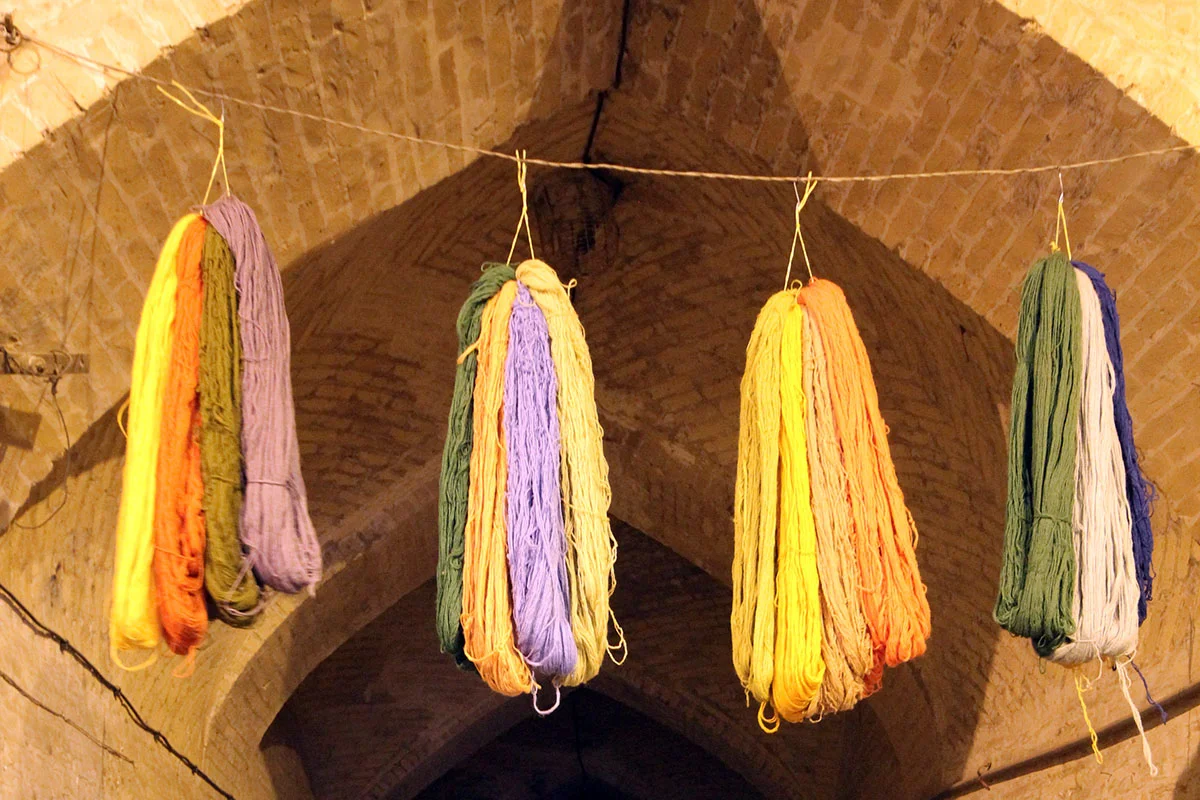
Art and Crafts
The talented people have artistic tastes in stone carving, architecture, tile work, painting and sculpture. Handicrafts of this province are mainly (Muaragh) wood macketry, Khatam (wood Inlaid) , calligraphy, Tahzib (illuminations), Silver work, copper work, cotton, cloth weaving and carpet weaving.
Shiraz Monuments & Attractions Tickets Price
Depending on the Iranian currency fluctutation agains US dollar, the entrance fee may incease every year for at least 20 percent in Rials. The following prices have been updated in 2023.
Fars & Shiraz UNESCO world heritage monuments & Museums Entrance Fee
Eram Garden: 500000 IRR
Pasargadea: 1000000 IRR
Persepolis: 1000000 IRR
Persepolis Museum: 1000000 IRR
Naghsh-e Rostan: 1000000 IRR
Nasghsh-e Rajab
Sarvestan Sassanid Palace: 1000000 IRR
Firuzabad Ardeshir Palace: 1000000 IRR
Bishapur City: 1000000 IRR
Bishapur Museum: 500000 IRR
Tang-e Chogan in Bishapur: 500000 IRR
Fars & Shiraz National monuments & Museums Entrance Fee
Hafez Tomb: 1000000 IRR
Saadi Tomb: 1000000 IRR
Jahan Nama Garden: 500000 IRR
Arg-e Karimkhan: 1000000 IRR
Vakil Hammam: 500000 IRR
Pars Museum: 500000 IRR
Haft Tanan Mansion & Museum: 500000 IRR
Kazerun Museum: 500000 IRR
Nurabad Museum: 500000 IRR
Neyriz Calligraphy Museum: 500000 IRR
Delgusha Gardens: 500000 IRR
Nasir-ol-Molk Mosque: 1000000 IRR
Forough al-Molk House and Museum: 500000 IRR
Qavam House (Naranjestan-e Qavam): 1000000 IRR
Zinat al-Molk House & Museum (Naranjestan-e Qavam): 500000 IRR
Moshir Mosque: 500000 IRR
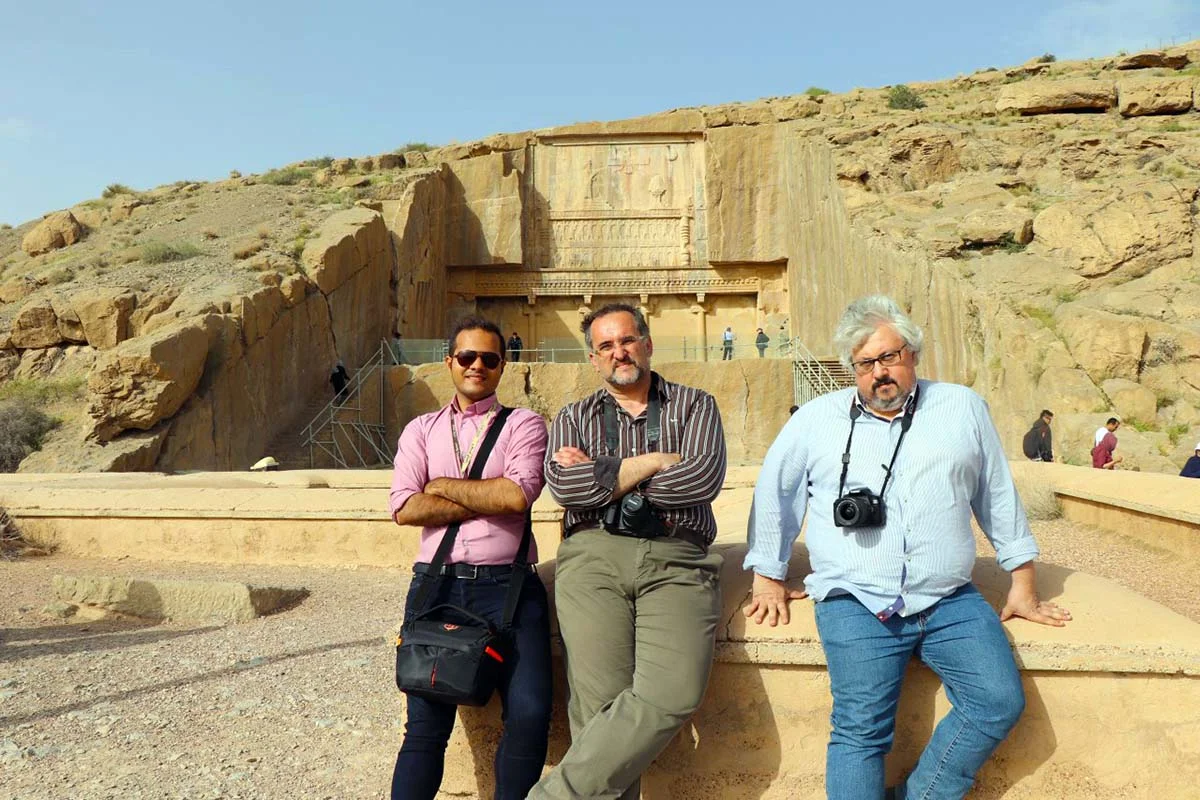
BOOK YOUR SHIRAZ CITY TOUR NOW
Uppersia Travel operates a variety of Shiraz tour packages including Shiraz city tours, Shiraz walking tours, Persepolis daily tour including Naghsh-e Rostam, Naghsh-e Rajab & Pasargadae tours, Bishapur our, Firuzabad tour, Nomad tour, Sarvestan tour, Maharlu tour, off-road tours and Shiraz cooking tours.

